Quest for the Puma
aka Mountain Lion
Torres del Paine, Chile
2013 Photo Safari Scouting Trip Report
We will be offering this shoot as a
Photo Tour in December 2015 and April 2016
Contact our office for more information.
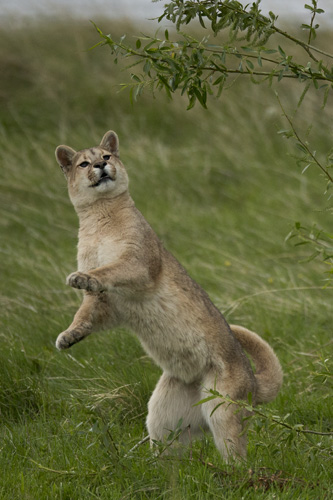
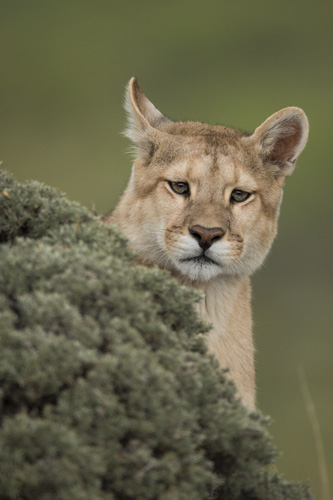 We did it! In one calendar year, 2013, Mary and I managed to photograph all seven of the big cats. I may be wrong, but I suspect no one has ever done this in one year! Our quest for the Puma, aka mountain lion or cougar, would be the most challenging and physically demanding, and the one species we most worried about seeing or photographing. Here's the report:
We did it! In one calendar year, 2013, Mary and I managed to photograph all seven of the big cats. I may be wrong, but I suspect no one has ever done this in one year! Our quest for the Puma, aka mountain lion or cougar, would be the most challenging and physically demanding, and the one species we most worried about seeing or photographing. Here's the report:
Just three days earlier we had returned from the southern tip of South America, completing a nearly month long Ultimate Antarctica cruise. Now we were heading back, within two hundred miles of that location, as we attempted to complete a grand slam, photographing all seven of the big cats in one year. We’d started with the Snow Leopard, and having successfully accomplished that goal, we had hoped we’d get Tiger, which we did, and the others – Lion, Leopard, Cheetah, and Jaguar – would be easy. Except the Puma, the most difficult and reclusive of all the big cats.
It is tragically ironic that this, the most wide spread of all the big cats, is also the most difficult to find and photograph. Mary and I have only seen Puma, or Mountain Lion, once in the US, and that was a distant view of a mother with cubs across the Flathead River in northern Montana. I’ve seen puma tracks in southern Arizona and plenty of sign, and tracks, in the remote high country of Zion National Park in Utah, but no other cats. We’ve had puma in southern Chile before, and returning there was our best chance of photographing all seven big cats.
Packing for this expedition was a challenge. We didn’t know what to expect, whether we’d have luck encountering a puma in the field or whether we’d need to resort to camera traps, either at kills or at a cave or potential den site, or whether we’d spot a cat at night with spot lights or infrared scopes. Consequently, we carried along an enormous amount of gear.
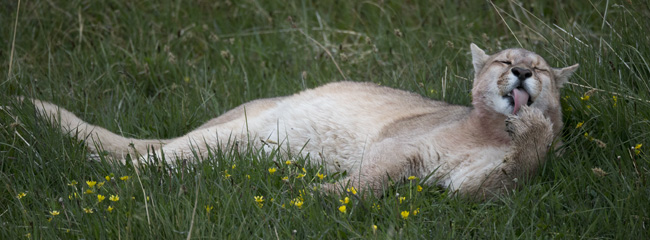
That gear included a 20-60 Spotting Scope for scouring the cliffs for a resting puma; an FLIR thermal imaging scope with a 2X zoom feature, to spot a cat’s heat signature at night; and two spot lights, for scanning the hillsides outside the park in the predawn. We used the thermal scope a few times, actually watching three pumas moving through the low vegetation, but had we not known that we were watching cats we may not have recognized the heat signature as anything significant. The Patagonian winds were problematic, and using a high powered scope for scanning cliffs was more trouble than it was worth, and we didn’t bother. That said, however, we’d bring a scope again, just in case, or to enjoy a cat we might spot that was too far away, or inaccessible, to approach for photography.
For remote work, I brought along two Range IR infrared camera traps, two Canon 7D cameras and 28-135mm lenses, and six Vivitar 285 flashes, two Really Right Stuff ground level pods and BH25 mini-ballheads, plus 8 Phottrix flash/camera remote radio controls, and 8 threaded metal rods, all for either kills or caves. I envisioned placing a Range IR and camera system inside a cave, facing out, to photograph a cat entering, or another system at a kill, keeping the system running overnight.
Learn how to use this type of equipment in our Advanced CNPC!
All of this equipment ran on batteries, so we had duplicate lithium AA and AAA batteries for all of the gear, a total of about 80 batteries. We did find one likely looking cave that, had we set up immediately, we could have had running for a few days, but concerned that something better might happen later, we passed. We also brought along one Trail Camera, and found a likely spot to place the camera but did not, worrying we might not return to that location.
On our last day, a fresh puma kill had attracted condors, and had I not set up there myself, one of the Range IR camera systems could have been used. Instead, this kill gave me the chance to try another accessory I brought along, a sniper-like Gillie suit, a camouflaged jacket, pants, and head net that allows one to practically disappear into vegetation.
We kept all of this ‘insurance’ gear inside the vehicle so that we’d be ready should the opportunity arose, storing pieces in different bags depending upon its use. Additionally, one bag had our 550 flashes, tele-flashes, and Wimberley flash brackets, in case we worked birds in the forest. While we searched there, we did not find any Magellanic woodpeckers or owls, birds where this flash gear could have been handy.
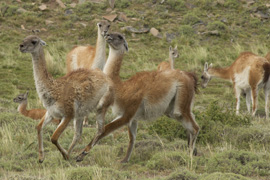
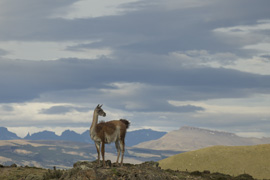
Our shooting, then, ended up to be rather conventional. My gear consisted of an 800mm and 70-300mm with either one or two camera bodies, generally packed in a Bataflae photo backpack for more comfortable hiking. I was using a Really Right Stuff long lens support for the 800mm, a piece of equipment I find essential with this lens, although it adds another pound or so to an already heavy system. Mary’s gear included a 500mm and 28-300mm lens, although for some hikes I’d pack her 500mm and she’d use a 400mm so that we saved on weight. I had a 28-300mm along as well, in case we spent more time shooting scenic, and both of us had 16-35mm zooms, polarizers, and one Singh-Ray 9X variable neutral density filter. Both of our primary cameras had Really Right Stuff L-brackets mounted on the camera for use in vertical or horizontal modes, and the little BH25 ballheads would have accommodated this. We forgot, however, that the BH25’s used a 3/8s screw, and we didn’t bring along bushings to mount a plate that would have allowed a quick add-on to the Wimberley head. Instead, if we wanted to use the BH25s, we had to completely change heads. Because of the time spent hunting pumas, however, we rarely had a chance to use the scenic gear.
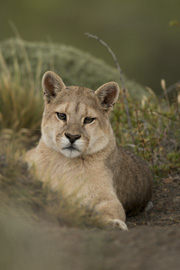 We brought along three Garmin 630 Rino GPS systems with two-way radios. This model will register the waypoint of the other person’s location when a radio transmission occurs, allowing one to walk, via the GPS, directly to that location. In the undulating steppes, interrupted by rocky ridgelines or massive outcropping ofconglomerate rocks, we were often out of sight of one another, and had one of us seen a puma, or injured oneself, these radios would be invaluable. The voice transmission isn’t the best, however, and so we purchased two Icom Marine Radios before the trip. Despite the best of planning, some contingencies arise that were unexpected. Unfortunately, though, I only brought along one charger for the Icom radios, and assuming that like most gear today the voltage would be 120-240, I plugged in the charging unit into a 240 outlet and fried the charger. Luckily, another piece of gear had the same female plug and we could still charge, but we didn’t discover that until a few days into the trip!
We brought along three Garmin 630 Rino GPS systems with two-way radios. This model will register the waypoint of the other person’s location when a radio transmission occurs, allowing one to walk, via the GPS, directly to that location. In the undulating steppes, interrupted by rocky ridgelines or massive outcropping ofconglomerate rocks, we were often out of sight of one another, and had one of us seen a puma, or injured oneself, these radios would be invaluable. The voice transmission isn’t the best, however, and so we purchased two Icom Marine Radios before the trip. Despite the best of planning, some contingencies arise that were unexpected. Unfortunately, though, I only brought along one charger for the Icom radios, and assuming that like most gear today the voltage would be 120-240, I plugged in the charging unit into a 240 outlet and fried the charger. Luckily, another piece of gear had the same female plug and we could still charge, but we didn’t discover that until a few days into the trip!
As we packed to go home, we looked at all this gear we didn’t use, regretting in some ways that we even brought it. But had we not had the luck we eventually had, and consequently had more hours in the day to deploy the gear, and more motivation or desperation to use it, we were covered.
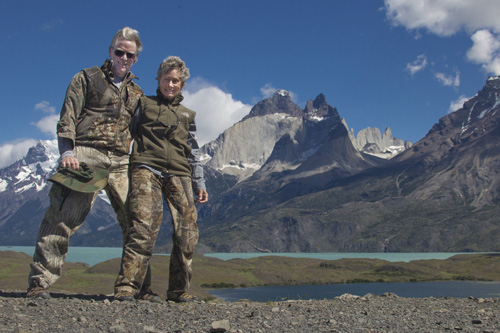
If our posture looks odd, its because we're leaning into a 40mph wind. One day, after hiking out 2 miles on a beautifully calm afternoon, the weather changed and we struggled back to the car in winds that may have reached 90mph! I was literally pushed dozens of yards across the grassland!
Clothing was another concern. While it was technically late spring or early summer, with their summer solstice just two weeks away, Torres del Paine can be cold, especially when there is a wind. And there almost always is a wind. On any given day we could have sun, wind, rain, wind, sun, and calm conditions, all within a few hours. Layering clothing was the best bet, and we always started the morning with three layers on our legs, with two pairs of varying weight long underwear, and camouflaged pants, and on top, four or five layers, starting with ‘next to skin’ long underwear, followed by another long sleeved tee-shirt, camouflaged shirt, wool sweater, and vest. In the field, we’d wear a medium weight camouflaged jacket over that.
Additionally, there were several different hats, wide-brimmed and ball caps for sun, wool caps for cold, and neck warmers, gloves, and mittens, for driving in the predawn. Mid-day we’d often still wear a light pair of wool gloves for some protection from the chill winds. We wore boots daily, with good ankle support for negotiating across the rocky slopes.
Mid-day, if the wind dissipated, we might be down to just pants, two layers on top, and a jacket, but we almost always carried a down jacket in our packs in case the weather changed, along with rain pants for blocking the wind or for sitting down on damp ground, or for rain, should it occur. Sitting at one location for hours, we’d often go through several clothing changes, shedding or donning layers as the weather changed.
Day 1. Arrival in Torres del Paine
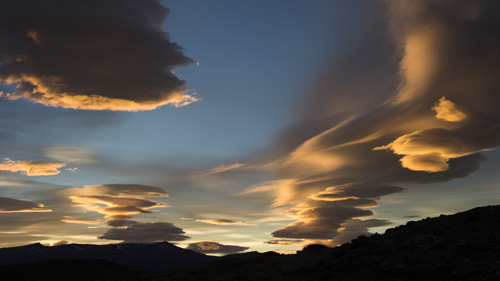
Partial sunlight and broken clouds hovering near the three great granite mastiffs of the Towers of Torres del Paine had me second-guessing as we unpacked and rested after driving all day, in preparation for a long day tomorrow. Were we wasting good light, or good weather, and simply being lazy?
We left our hotel at 9AM this morning, after an overnight flight and a day spent traveling down the spine of the Andes yesterday. It had been several years since we’ve made this fly-over and watching the scars of retreated glaciers, I regretted not having photos or a better memory – were the glaciers that far back ten years ago? Many glaciers were obviously in retreat, but as we traveled further south enormous ice fields covered the mountains from one peak to another, and the Puerto Moreno Glacier still crept down to create its usual bottle-neck at Lagos Argentina.
Subduction of the Pacific plate created the Andes, as that tectonic plate slid beneath the continent of South America. The stress of this has caused the Andes, and the volcanoes that periodically poked above the clouds. Recent volcanoes, they are covered in snow and so perfectly formed they are the exact copy of any kid’s drawing, a perfect, white-capped, conical peak.
Concerned about our mileage and gas, we lingered at Sona Franca, a huge complex of specialty stores, where we spied plastic and metal gas cans. We purchased two plastic cans, giving us an extra 30 liters of gas, and as it turns out we’ll probably need it. Our lodging is a comfortable little cabin at Hosteria Tyndall, along the shores of the Rio Serrano, but unfortunately this position puts us about 50 kilometers, or a 1.5 hour drive, from the area we normally drive to hunt for pumas. As we headed to our cabin we were struck by the size of the park – we didn’t remember this long of a drive, and we worried that our cabin and the hotel complex would be accessible only by ferry. Years ago, we’d checked out this lodge when, in fact, there was no road access, and the only way in was by a ferry which would not be operating at 4AM when we started our drives.
Fortunately a road now leads to the Serrano Hotel complex and to Tyndall, along a recently cut road where, as we ascended, an Andean Condor descended, flying over the road and into the valley. On our drive north we’d seen over a dozen condors, the first one I almost mistook for a small plane. They are big birds! Several of the dozen or so we saw hung in the wind, and Mary could see the white ruff-like collar that distinctly marks this bird. Brown-hooded Gulls, Buff-necked Ibis, Kelp Gulls, Crested Caracaras, and the pink dots of Chilean Flamingos marked our drive, along with one Patagonian Gray Fox that trotted across the road and along the berm for a short while.
Unpacking took over an hour, as we sorted the equipment we might need if we set up an infra-red system at a carcass, the gear we’d carry afield, and the cameras and lenses we’d use for traditional photography when we were not searching for 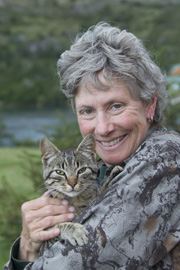 pumas. I was a bit worried that our luggage might be inspected on the way in, as we looked like we were more spies than photographers, having a rag-like, bushy Gillie suit, which I hoped to use as a blind if we worked a kill; a thermal-imaging scope that I received, via a UPS drop-off station, the day we left the US; three Rhino GPS units, in order to locate each other, and perhaps a friend, if we separated to search; and two new Icom two-way Radios for better communication. This along with a 20-60X spotting scope, more camou, two huge telephotos, and six different radio-triggered flash/camera transmitters and receivers, and two pairs of binoculars – an 18X IS version, and a standard 10X. I do not think we looked like the average tourist visiting TdP!
pumas. I was a bit worried that our luggage might be inspected on the way in, as we looked like we were more spies than photographers, having a rag-like, bushy Gillie suit, which I hoped to use as a blind if we worked a kill; a thermal-imaging scope that I received, via a UPS drop-off station, the day we left the US; three Rhino GPS units, in order to locate each other, and perhaps a friend, if we separated to search; and two new Icom two-way Radios for better communication. This along with a 20-60X spotting scope, more camou, two huge telephotos, and six different radio-triggered flash/camera transmitters and receivers, and two pairs of binoculars – an 18X IS version, and a standard 10X. I do not think we looked like the average tourist visiting TdP!
What we hoped would be a favorable omen appeared as we walked the hundred yards to our cabin. A friendly, and beautiful, tabby House Cat ran up to us and, as cats often will do, ingratiated itself with us. We were seduced immediately.
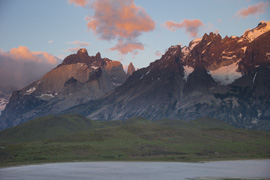 Day 2. Wind. We awoke at 3:15AM and the Towers were framed by a field of brilliant stars. By 3:50 we were on the road, and arrived at our scouting area just as the skies began to lighten, making the use of the expensive thermal imaging scope unnecessary. Guanacos were whistling an alarm, a good sign that a puma had been sighted, but we couldn’t spot the cat. The skies were spectacular, however, and diverted our attention as we photographed the incredible lenticular clouds, glowing orange and yellow, in a very heavy wind.
Day 2. Wind. We awoke at 3:15AM and the Towers were framed by a field of brilliant stars. By 3:50 we were on the road, and arrived at our scouting area just as the skies began to lighten, making the use of the expensive thermal imaging scope unnecessary. Guanacos were whistling an alarm, a good sign that a puma had been sighted, but we couldn’t spot the cat. The skies were spectacular, however, and diverted our attention as we photographed the incredible lenticular clouds, glowing orange and yellow, in a very heavy wind.
The wind never abated, and when we finally decided to go cross-country on foot the wind was sometimes so intense that we were, without exaggeration, blown sideways or pushed forward. Coscoroba Swans, stout, short-necked birds that resemble geese more than a graceful swan, took flight when we neared their pond and several of the birds, facing into the wind, literally hung in the air, making no forward progress against the gale. Chilean Flamingos and other swans were smarter and simply flew the lake, with the wind, where they landed far on the opposite bank.
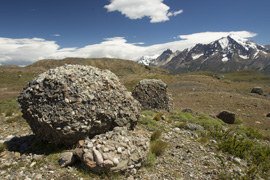 We checked multiple cliffs and ridges, but in the wind every bend was an ordeal as we were simply pummeled by the blasts. At 11 we found a quiet spot and snoozed for an hour or two before continuing our search. We saw no cats.
We checked multiple cliffs and ridges, but in the wind every bend was an ordeal as we were simply pummeled by the blasts. At 11 we found a quiet spot and snoozed for an hour or two before continuing our search. We saw no cats.
In mid-afternoon we investigated an area where a stone hide, or blind, had been erected, probably for condor photography. We located a few spots where a Trailcam might be useful, but saw no definitive signs of a puma.
When we returned to our car a group of Guanacos, the southern Andes version of the camel, had gathered near the road. Mary was going to take some shots but the guanacos were doing nothing, and I almost dissuaded her from shooting. Instead, we decided to just hang out and watch, and enjoy the guanacos and see what they would do.
The herd accepted us, and as they got up from resting positions most moved closer. One female caught our attention, as she appeared heavy and swollen, as if she was about to give birth. She got up and switched position several times, usually moving closer when she did so. As we watched, we saw that she was beginning to drip, as if her water had broken, and as she moved about she eventually settled nearby, but behind some screening brush.
She rose, and the hooves of her baby were visible. Over the next half hour she periodically lay down or stood, and the head and forelegs of the baby appeared. Mary was using a 500mm and had nearly perfect framing, while I was using an 800, much too big a lens for the distance we were working, and I switched to a 70-300 as the guanaco rose, rotated in a half circle, and dropped the baby, practically in
front of us and in perfect view.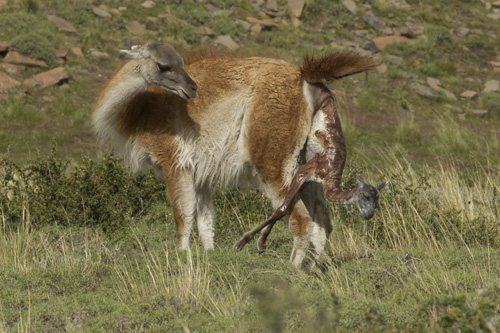
Almost immediately, several members of the herd gathered to inspect the newborn, and as the baby finally got to its feet it almost imprinted on one guanaco that stayed by the mother the entire time after the birth. As that guanaco moved off the baby attempted to follow, but the female would try to get in front, blocking the baby’s progress, although the baby tried hard to keep up with the wrong mother. Eventually that guanaco moved off and the baby settled with its true mother, who proceeded to either graze or chew its cud while the baby slowly gathered its legs and balance and began searching for a teat.
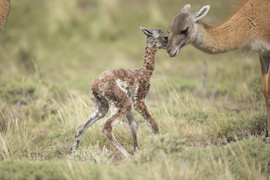
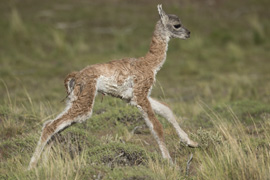
It took a surprisingly long time for the baby to finally nurse, but soon after that action triggered the female into expelling the afterbirth, a bulbous mass and nearly three foot long string of tissue. During the entire time the female never groomed or licked her baby, whose curly, matted fur eventually began to dry and frizz. Other babies were now fully fuzzy, and we suspect they had been born earlier in the day. Some other females looked as if their birthing was imminent, but judging by what we’d just seen not within the next few hours. We suspect that they might give birth tomorrow.
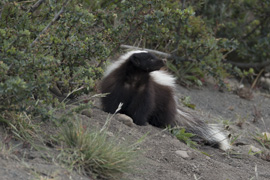 While we were considering leaving, a Hognose Skunk, with an usual tan-brown back, appeared. When it tried to cross the road several guanacos took chase, following it closely as it ran into the brush. None of the guanacos tried to kick or stamp the skunk, who eventually settled next to one of the likely-looking pregnant guanacos, where the skunk dug for grubs unmolested, just a few yards from the guanaco.
While we were considering leaving, a Hognose Skunk, with an usual tan-brown back, appeared. When it tried to cross the road several guanacos took chase, following it closely as it ran into the brush. None of the guanacos tried to kick or stamp the skunk, who eventually settled next to one of the likely-looking pregnant guanacos, where the skunk dug for grubs unmolested, just a few yards from the guanaco.
We headed back to our cabin, an hour drive in beautiful light, tempting us with scenic but with another early start planned, we wisely headed home, where downloading still awaited.
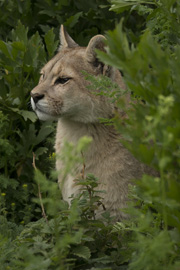 Day 3. We left at 4:20 this morning, for after speaking with our friend Diego, we were advised to patrol for pumas at first light, and not predawn as we had been accustomed. By 5:15 we were in our area, stopping for a few minutes to speak with Diego before we continued. His group had a scout car that took a different road, and as it turned out, had action.
Day 3. We left at 4:20 this morning, for after speaking with our friend Diego, we were advised to patrol for pumas at first light, and not predawn as we had been accustomed. By 5:15 we were in our area, stopping for a few minutes to speak with Diego before we continued. His group had a scout car that took a different road, and as it turned out, had action.
Meanwhile, we followed the same route as yesterday, and I half-expected to find pumas on a fresh quanaco kill, perhaps even one of the babies we photographed yesterday afternoon. We did not find a kill, and all of the guanacos in the area were settled and relaxed, without any alarm calls. Near the end of our intended route we did find an immature Andean Condor and a Crested Caracara perched on a rock outcrop close to the road, which made us suspicious, but we found nothing. The condor cooperated, however, allowing the closest approach I’ve ever had with this bird.
Mary worked on the spring Orchids, with one species resembling a Moccasin Flower from home, with a deep yellow scalloped petal. When she finished we continued on to the puma cliffs, and although I was tempted to stop and hike because of the amazing lack of wind, Mary suggested we continue and do the lake where, along the shoreline, caves sometimes shelter pumas.
As we descended the plateau we passed our friend’s vehicle and a short distance beyond saw Diego and his group along a small lake shore. No one was photographing, and we almost drove on, but since we knew that caracaras sometimes nested there, we stopped to ask what they were shooting. Diego’s shocking reply, three pumas!
We had hoped to find a puma on our own, a personal, perhaps pig-headed challenge, but we knew that on any given day the likelihood of finding another cat was extremely slim. We asked if it would be okay to join in and received permission, with the caveat that this was ‘their’ puma and Diego would call the shots. If we found the cat first, we’d have the same privilege, which are the basic operating rules we try to work out when we’re dealing with people in crowded Yellowstone. Sometimes it works there, and sometimes it doesn’t, but here the system generally works quite well.
I’ve known Diego for over ten years, meeting him for the first time when Mary and I did our first solo trip to the area, hoping to see pumas. Dressed in dusty camouflage clothes, Diego sauntered down the road, stopping to say hello and to ask what we were doing. He recognized kindred spirits, of course, as we were dressed in camou as well. Somewhat guardedly, we exchanged some information about what we were doing, and Diego shared that he had helped some major film crews find pumas. He offered to help us, but we declined, as we stubbornly hoped to find a cat ourselves.
That evening, Diego found a mother puma with two cubs, and stayed with them until he was walking the steppes in almost complete darkness. The small video camera he was using functioned almost like a night scope, allowing him to see the cats where, with his naked eye, they were invisible. As darkness fell the cats became more and more inquisitive, running close by as they played, and he worried that things might get out of hand. Ten years ago, puma habituation was still in its infancy, and Diego as one of the pioneers was still amassing experience.
Two days later, on one of the winding roads we met Diego again where he showed us his video. We had a strong opinion of him then, and welcomed any help we could receive. We didn’t find another puma on that trip but on future visits we always made arrangements to meet up. Diego was with clients this time, but he invited us to join him if he spotted a cat and we accepted.
We unloaded our cameras, tripods, and backpacks, and Mary stayed by the road while Diego hopped into my car and directed me to a distant spot to park. Many tours hunt for cars, he explained, and a cluster of cars might attract a crowd of tourists that could impact upon our puma watching. We found a spot a half mile down the road.
When we arrived back, Mary was already on site, along with my gear, carried by one of Diego’s spotters. Diego had come a long way since we first met, and now owned three vehicles, camping equipment, and employed two spotters to assist in finding cats. Rodrigo has been Diego’s best friend since college, where they both studied marine biology. Rod is a skilled photographer himself, one of Chile’s best known wildlife photographers, and one of his images of a puma caught the attention of a girl. A veterinarian, Christina, was so moved by the beauty of the image that she wanted to meet this photographer, and later, in researching to take her first photography class, she learned Rod was the best. Eventually, Christina left veterinary medicine and became a guide in Torres del Paine, and where, just ten days earlier, she found Rod’s hidden engagement ring tucked in a hollow of a limestone cliff. The two would be married next year.
It was now nearly 7 or 7:30 when we arrived on site, to discover that a mother Puma and her two cubs had killed, and had been feeding upon, a guanaco only about 50 yards off the road. By the time we arrived the cats had retreated to a small thicket, composed of willows and leafy shrubs that lined the grass and reed-lined shoreline of the lake. The cats were hidden, and having fed, we knew we’d have had absolutely no chance of spotting them had we not seen our friend.
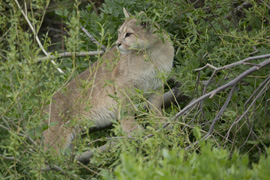 Over the next hour or so the cats periodically raised their heads from the brush, and one of the young climbed one of the willow trees, ascending into the lower branches before jumping off and disappearing once more into the vegetation. By 10 the action had stopped, and our friends headed back to their hotel for showers and downloading, planning to return by 5PM when the cats might resume their activity.
Over the next hour or so the cats periodically raised their heads from the brush, and one of the young climbed one of the willow trees, ascending into the lower branches before jumping off and disappearing once more into the vegetation. By 10 the action had stopped, and our friends headed back to their hotel for showers and downloading, planning to return by 5PM when the cats might resume their activity.
For Mary and I, three hidden cats in the bush were worth … well, anything, since we had come to photograph pumas and cats were there, albeit hidden right now. Diego and his two scouts, Christina and Rod, believed the cats would wake up at some point and perhaps play, and although a lot of down time would be involved they thought we would get something.
And so we waited. While we did so, we discovered that the pumas had actually killed two guanacos during the night, an adult, which they had been feeding upon, and a newborn, or chalingo, that they had abandoned. An Andean Condor eventually discovered the kill and visited, dropping out of the sky with set, motionless wings and feet hanging low, but each visit was brief, and the huge bird 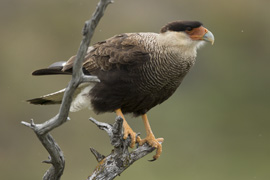 looked nervous. A Crested Caracara perched on a tree close to us, and tolerated a close approach, and various birds, Negritos, Thrushes, and Sparrows, offered some diversion as the hours passed.
looked nervous. A Crested Caracara perched on a tree close to us, and tolerated a close approach, and various birds, Negritos, Thrushes, and Sparrows, offered some diversion as the hours passed.
At one point, two male Guanacos, in a serious fight, came charging past us, dropping over the bank and directly into the brush where the three pumas lay. One awoke, and charged the guanacos, but the puma was one of the cubs, although nearly full-grown, and I suspect the charge was as much play as anything. It missed, of course, and the cats settled down again after giving us a few quick shots as they moved through openings and back into the brush.
One of the two cubs was tailless, with only the merest nub of a tail, which may have been a birth defect and not an accident, as the cub was tailless from the first time it was spotted, only a few months old. Most tailless or partially bobbed cats lose their tails in fights, or, at least in Africa, in run-ins with hyenas, but no predator other than a male puma could account for this, and a male puma would have surely killed the cub if it bothered to even maim it.
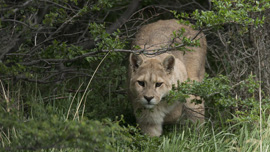
A large herd of guanacos gathered in the field adjacent to the woodlot, about 75 yards from where the cats were sleeping. New born calves accompanied their mothers into this pasture, and adults sparred and mated, but the cats showed little interest. Eventually, however, two male guanacos got into a serious fight, racing about as one chased the other, attempting to castrate its rival when it neared. Guanaco fights involve rearing, kicking, and a lot of screaming, and all of this activity finally awakened the interest of the tailless puma. It appeared at the edge of the brush, watching, and, finally, too teased by the proximity of prey, the puma charged the guanacos.
They had seen it coming and merely ran off, with plenty of alarm whistles, a hoarse laughing cascade. The cat returned to cover, but the session was good, and we felt that the wait had been worthwhile. The racket, however, had attracted the mother, which we hadn’t seen, and now in the brush less than thirty yards away from where we sat, three pumas lay hidden.
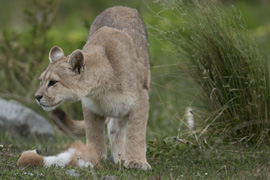
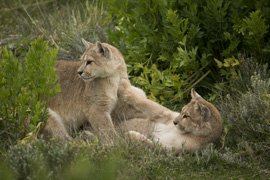
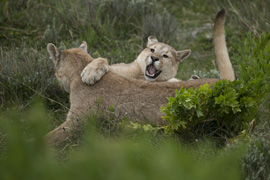 About 5 our friends returned, and soon after the two cubs awoke and began to play, racing around the brush, jumping, and occasionally wrestling with one another. Over the next two hours the cats continued to show themselves, playing, chasing, climbing trees, wrestling with each other, giving us an incredible show. At one point, when we had all moved to a different vantage, one of the cubs walked up to where Mary and I had laid our Bataflae backpacks and our lunches, and we were afraid that the cat would either destroy or run off with something. Instead, it merely sniffed and continued on, walking quite close to us as it dropped back to the playing field.
About 5 our friends returned, and soon after the two cubs awoke and began to play, racing around the brush, jumping, and occasionally wrestling with one another. Over the next two hours the cats continued to show themselves, playing, chasing, climbing trees, wrestling with each other, giving us an incredible show. At one point, when we had all moved to a different vantage, one of the cubs walked up to where Mary and I had laid our Bataflae backpacks and our lunches, and we were afraid that the cat would either destroy or run off with something. Instead, it merely sniffed and continued on, walking quite close to us as it dropped back to the playing field.
By 7:30 the cats appeared to be interested in their kill, and most of us headed uphill to overlook the carcass. Mary stayed behind, not wishing to add to the small crowd – the six of us in the group. Both cubs soon appeared, feeding unconcernedly in the falling light. I did mostly video, although eventually I switched back to film. Meanwhile, the female stayed behind at the thicket, where she called and meowed and chirped, eventually drawing the two cubs back.
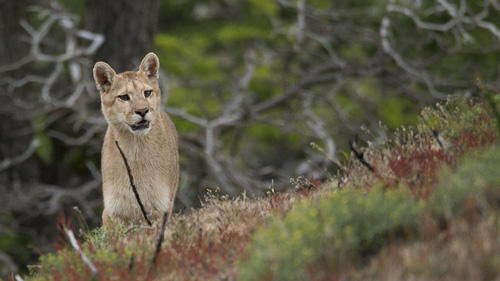
While Mary waited she photographed the mother licking and grooming the bloody muzzle of the tailless cub, and photographed the two wrestling and playing. Later, the tailless cub walked almost directly to Mary, stopping so close that the puma’s head literally filled her frame! The second cub was following the other, but the tailless cub attacked, initiating another play fight which carried them off into the brush.
It had begun to rain lightly, and the light was failing, and concerned that the mother may be holding back to feed after we’d gone, we stopped the shoot and headed back to our vehicles. At times we were with 30 feet or so of the cats, or they to us, as we never approached them but instead their own curiosity and playfulness brought them so close. In all, Mary and I had spent 13 hours in the company of these cats, and while they were often hidden, we were within forty yards as they slept, and this, after they had approached the thicket close to us to do so.
We arrived back at our cabin by 10PM, celebrating one of the most satisfying and successful field days we’ve ever had. Clouds shrouded the Torres mastiff, and still having nearly 1.5 hours of downloading and cleaning to do, we decided to sleep in tomorrow, and work on other subjects once we started the day.
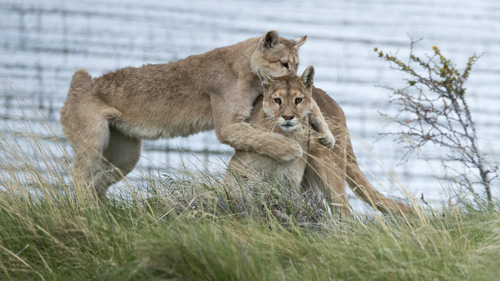
The tailless cub wrestles with her mother. Although the cub is only 9 months old,
she is 2/3rds the size of the mother, and looks like an adult.








If you'd like to get the latest information on our trips, especially new trips or
unexpected openings, sign up! We do not share our email list with anyone.
Day 4. We didn’t get to bed until midnight, caught up with a quick, preliminary review of the nearly 2,000 images each of us shot yesterday. Although we awoke at 4, 5, and 7, we managed to roll over and fall back to sleep, until finally, at 11AM we pulled ourselves out of bed. Almost an 11 hour sleep, and as our energy level showed throughout the day, it still didn’t seem to be enough. We were in second gear all day.
Mary cooked a hearty brunch of chorizo sausage, toast, and fried eggs, and by 1PM we finally left our cabin. Our intentions were to explore the Lago Gray area for Huemel, the southern South American deer that resembles a whitetail in many ways, Magellanic Woodpeckers, one of the world’s largest species, and Torrent Ducks, the South American ecological equivalent of an American Merganser or Harlequin Duck, as this species inhabits fast mountain rapids. We found none of the above.
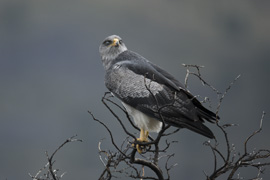 Instead, on our drive in Mary spotted a beautiful Black-chested Buzzard Eagle, a large, gray colored raptor fairly close to the road. Mary made some shots out of the car window before I tried sneaking out and shooting with my 800mm from the roof top. Both worked well. Later, as we neared the park area, we spotted a Blackish Rail strutting about on the berm. This long-billed dark gray rail closely resembled its Pantanal relative, the Wood-Rail, and acted similarly, darting into vegetation and disappearing easily. I shot some mediocre frames as it ran across the road but had much better luck when it unexpectedly appeared in a small clearing, just outside the minimum focus of my lens, for very nice images.
Instead, on our drive in Mary spotted a beautiful Black-chested Buzzard Eagle, a large, gray colored raptor fairly close to the road. Mary made some shots out of the car window before I tried sneaking out and shooting with my 800mm from the roof top. Both worked well. Later, as we neared the park area, we spotted a Blackish Rail strutting about on the berm. This long-billed dark gray rail closely resembled its Pantanal relative, the Wood-Rail, and acted similarly, darting into vegetation and disappearing easily. I shot some mediocre frames as it ran across the road but had much better luck when it unexpectedly appeared in a small clearing, just outside the minimum focus of my lens, for very nice images.
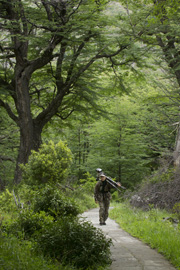 At Lago Gray, where the Gray’s Glacier has well sculpted icebergs stranded along the broad beach, we searched for our target species without success. I did some back-country hiking to look for the Huemel, and perhaps because it was a still, relatively warm day, or more likely, my butt was simply dragging after the last two days, I was soaked with sweat after the hike. We had intended to drive back to the puma area and be there by 5, but it was 5 before we even reached the crossroads where we’d turn for another hour’s drive, and our gas tank was reading only 1/3 full. Worried about the gas situation we headed to park headquarters where we learned that a local in the settlement where we were staying sold gas, and we filled up there. It began to rain, and our intention to hunt for pigmy owls dissolved in the rain and instead Mary warmed over our spaghetti dinner from our first evening as we drank wine and, at only 8PM, looked forward to a good night’s sleep.
At Lago Gray, where the Gray’s Glacier has well sculpted icebergs stranded along the broad beach, we searched for our target species without success. I did some back-country hiking to look for the Huemel, and perhaps because it was a still, relatively warm day, or more likely, my butt was simply dragging after the last two days, I was soaked with sweat after the hike. We had intended to drive back to the puma area and be there by 5, but it was 5 before we even reached the crossroads where we’d turn for another hour’s drive, and our gas tank was reading only 1/3 full. Worried about the gas situation we headed to park headquarters where we learned that a local in the settlement where we were staying sold gas, and we filled up there. It began to rain, and our intention to hunt for pigmy owls dissolved in the rain and instead Mary warmed over our spaghetti dinner from our first evening as we drank wine and, at only 8PM, looked forward to a good night’s sleep.
Day 5. Another early start, rising at 3:30AM and out the door by 4:15 as we headed to the pumas once again, hoping that they’d still be at the kill. En route we met Rodrigo and Christina, Diego’s scouts, who were headed in the same direction and where we learned that the pumas performed well last evening, although the light was poor. We’d looked to the east and had figured they’d have rain, and with the gas situation decided against the trip. Now feeling refreshed after a relaxing day yesterday, we did not regret our decision.
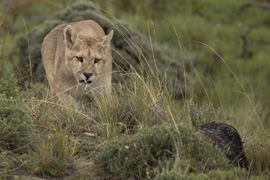 The pumas were just leaving the kill when we arrived, with the mother and the two cubs slowly walking up hill to a small forest. Rodrigo and Christina were packed and ready to go and began following the cats, while Mary and I repackaged our long lenses into our Bataflae bags for an uphill hike of unknown length or duration. Fortunately, the cats settled down at the first woods, where they lay in the open in beautiful low grass.
The pumas were just leaving the kill when we arrived, with the mother and the two cubs slowly walking up hill to a small forest. Rodrigo and Christina were packed and ready to go and began following the cats, while Mary and I repackaged our long lenses into our Bataflae bags for an uphill hike of unknown length or duration. Fortunately, the cats settled down at the first woods, where they lay in the open in beautiful low grass.
The cats were a bit more sedate, moving about and chasing one another for a few times. The mother disappeared into the forest where she slept, while the tailless cub attempted a stalk of a couple of guanacos on the upper slope. She squirmed and reset her hindquarters as if to charge but the guanacos never came close and eventually she lost interest and she headed into a lower section of forest.
I was busy chatting with Diego while most of the group moved lower to watch for the cub. Two guanaco males were fighting and in the chase that usually results one ran close to the lower woods where the tailless cat had emerged, and was now lying flat in the low growth only fifteen meters from the unsuspecting guanaco. At about that time we realized something was happening and scrambled down with our gear, but the guanaco had taken off and, to everyone’s surprise, the puma didn’t even move.
We’ve seen this type of unexpected behavior many times with many cats, where the prey seemed so close that a chase or kill seemed inevitable. In this case, an adult male guanaco was far too big for the nine month old cub to kill, but a chase, or even a jump onto its back, was possible. It didn’t happen.
Soon after all three cats retreated to the nearest forest, about sixty yards from our position, where they remained until 5:30PM. Mary and I remained behind, figuring that three cats in the bush beat anything else, and perhaps a chalingo, a baby guanaco, might wander by. So we waited, in perhaps the most pleasant afternoon we’ve had, sunny and so warm we stripped down to our thinnest layers. A Cinnerous Marsh Hawk sailed by on teetering wings several times, flaring its tail and swooping at the trees, hunting for birds. One condor flew overhead, but never circled to investigate the baby guanaco yesterday’s condor fed upon, or the adult guanaco carcass.
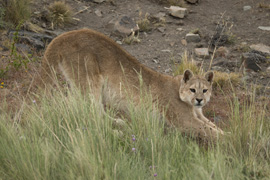
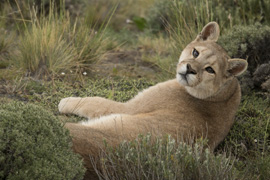
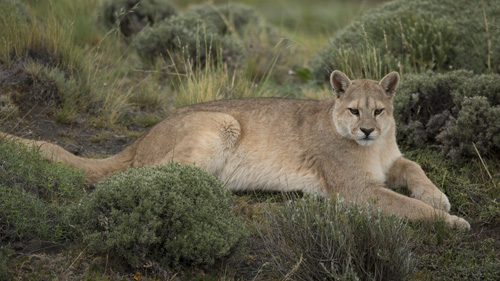
All of our exposures were shot in Manual Mode, Spot Metering. Although we had brought along flashes, camera traps, etc. we ended up not needing this equipment. However, if you'd like to master photography skills, or learn all you'll need to know about flash, camera remotes, and more, check out our Digital Complete Nature Photo Course or our Advanced (Flash) DCNPC.
At 5:30 the rest of our friends arrived, and within minutes the two puma cubs emerged from the forest. We were expecting play behavior, but after a few chases both cats headed toward the kill. Fortunately they paused several times, affording wonderful shots, although I missed a dream shot, where the puma, full-frame in a vertical format, was walking toward me! My Wimberley knobs were locked tight, and by the time I loosened the knobs and repositioned the cat had moved. The pose lasted only seconds, but I missed it.
Nonetheless, the two cubs presented several wonderful views as they lay on the trail before us, or looked around bushes, or walked so close that the cats were head shots with my big lens. They walked directly to the kill which was far below 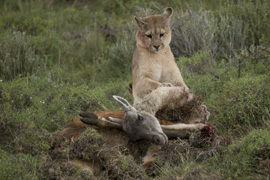 us from our present position. Both cats fed for a short time, then moved further downhill, appearing to be heading to the small lake where our encounters began two days ago. Vehicles driving up the road stopped their progress, and both cats hunkered down. The tailed cub returned to the kill, just as we were calling it a day, but we dropped down to a lower level where Mary and I filmed and shot the cat as it fed, played on the carcass, dragged it, and shook the neck of the guanaco. Eventually it headed off and we continued downhill.
us from our present position. Both cats fed for a short time, then moved further downhill, appearing to be heading to the small lake where our encounters began two days ago. Vehicles driving up the road stopped their progress, and both cats hunkered down. The tailed cub returned to the kill, just as we were calling it a day, but we dropped down to a lower level where Mary and I filmed and shot the cat as it fed, played on the carcass, dragged it, and shook the neck of the guanaco. Eventually it headed off and we continued downhill.
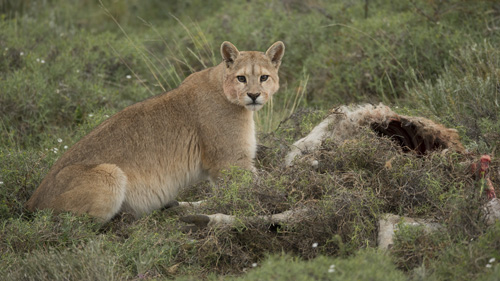
Check out our Trip Reports for the stories behind our other Big Cat adventures.
At 8PM we headed home, stopping en route when Mary spotted a chick riding amongst the feathers of one of the parent Black-necked Swans feeding close to the road. We stopped, but by the time Mary could dig out her lens and brace it on the window frame of our car, just seconds too late, the chick dropped off the adult. We still photographed the birds quite close, but the magical shot was gone. We continued home, arriving at our cabin at 9PM.
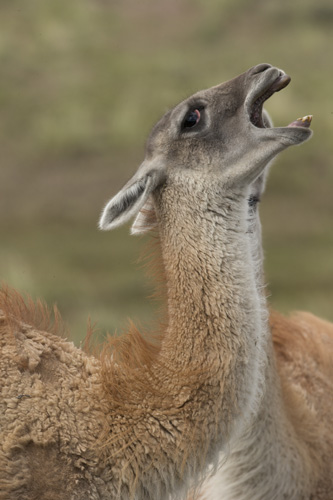
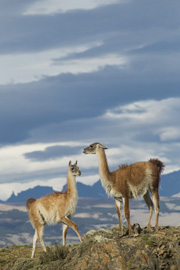 Day 6. We were on our own today, without the benefit of other scout cars and without a known kill where pumas were likely to be. We drove along all the likely locations, leaving our cabin at 4:20AM and arriving on site around 5:10. After our first run we stopped to shoot the Horns and Towers in a mediocre sunrise, fighting hurricane force winds as we did so. We continued on towards the condor blind area, where the guanacos had given birth three days ago. Although we planned on hiking out to the Castle, the winds were a gale, and instead we settled down for a nap, which began at 7AM and ended at 10AM! When we awoke, the guanacos were before us, and a van-load of tourists were outside, aiming their cameras at a guanaco. I commented that perhaps it was giving birth, and indeed it was!
Day 6. We were on our own today, without the benefit of other scout cars and without a known kill where pumas were likely to be. We drove along all the likely locations, leaving our cabin at 4:20AM and arriving on site around 5:10. After our first run we stopped to shoot the Horns and Towers in a mediocre sunrise, fighting hurricane force winds as we did so. We continued on towards the condor blind area, where the guanacos had given birth three days ago. Although we planned on hiking out to the Castle, the winds were a gale, and instead we settled down for a nap, which began at 7AM and ended at 10AM! When we awoke, the guanacos were before us, and a van-load of tourists were outside, aiming their cameras at a guanaco. I commented that perhaps it was giving birth, and indeed it was!
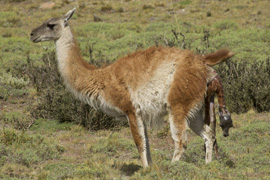 We awoke just as the baby’s head and forelegs were emerging, and the mother circling constantly in one spot as she pushed out the baby. I shot the entire sequence with a 70-300mm, and Mary backed up for her 500mm. After the birth, the baby finally gained its footing at 30 minutes, and kept upright from that point on. We continued down to the Laguna Amarga Gate, where we photographed the Towers and some guanacos that waded in the river.
We awoke just as the baby’s head and forelegs were emerging, and the mother circling constantly in one spot as she pushed out the baby. I shot the entire sequence with a 70-300mm, and Mary backed up for her 500mm. After the birth, the baby finally gained its footing at 30 minutes, and kept upright from that point on. We continued down to the Laguna Amarga Gate, where we photographed the Towers and some guanacos that waded in the river.
Returning to puma country, we hiked in towards the Castle, but we had only two hours before we were to meet Rod and Christina and travel in tandem with them to Lago Azul, where we hoped to film Silver Grebes. The Castle search was unproductive, although Mary found some cliffs with caves that she felt were very promising and deserving another look tomorrow.
Christina and Rod were late, so we continued on, stopping at the Cascades where, against another gale, we shot a scenic of the rapids and the Towers, and continued on to Azul. Huge herds of guanacos lined the way, and we were told that a female Puma with four large young hunted that game-rich area.
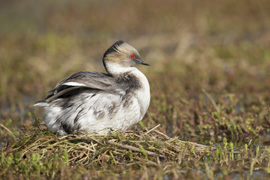 The Silver Grebe marsh was ideal, with birds nesting on low clumps of vegetation they had dragged up and built a floating nest. We were concerned that we might spook the birds, so we approached carefully, and I literally crawled the last several yards for a ground- or water-level perspective. The birds remained on their nest.
The Silver Grebe marsh was ideal, with birds nesting on low clumps of vegetation they had dragged up and built a floating nest. We were concerned that we might spook the birds, so we approached carefully, and I literally crawled the last several yards for a ground- or water-level perspective. The birds remained on their nest.
We were hoping to photograph adults with chicks riding on their backs and we had several opportunities to do so. With one chick riding one adult, the other constantly dove and captured some aquatic insect, with a rapidity and consistency that was amazing. Every dive produced a tidbit, and most dives were incredibly short. One larger chick had 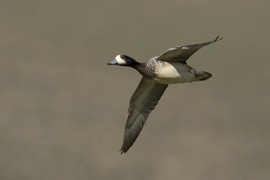 hopped off the adult and later attempted to reclaim its position, squirming in and comically kicking with its webbed feet to push itself into the feathers.
hopped off the adult and later attempted to reclaim its position, squirming in and comically kicking with its webbed feet to push itself into the feathers.
The Silver Grebe is a striking bird with vivid red eyes and a flare of yellow feathers passing behind its ears. Young birds were striped, red-eyed, and snake-like, and the chick would reach out, snatching the offering from the other adult in moves almost too quick to frame. Christina and Rod arrived late, and they walked upright and close, with the birds never deserting the nests. Rod said they never do, and even adults with chicks swam close-by, which we found remarkable.

We left after 7:30 when our other friends arrived, wishing to shoot in ‘better light’ although clouds now hung threatening against the western horizon. Although it was after 8:30, we decided to scout out the entire area for pumas before heading home. We had no luck, and in a driving wind arrived back at our cabin at 10:04PM, the latest yet, giving us too few hours of sleep for tomorrow, our last day.
 Day 7. We didn’t get to bed until midnight, and rising at 3:30AM was difficult. Wind shook our small cabin, so conditions didn’t look promising, and sleeping in was a temptation we found hard to avoid. We did, however, and were on the road at 4:18, reaching the puma area by 5:15. The Towers and Horns were beautiful, bathed in a soft orange light, but we were focused on finding pumas and ignored the landscapes. Both roads offered nothing, but near our turn-around point we spotted Andean Condors dropping from the sky. I walked out to investigate, getting quite close to the birds before they took off. They were watching, and perhaps feeding upon, a young Guanaco puma kill, with the bloody throat from the cat’s hold, and the rib cage exposed and eaten, a certain mark for a puma in South America.
Day 7. We didn’t get to bed until midnight, and rising at 3:30AM was difficult. Wind shook our small cabin, so conditions didn’t look promising, and sleeping in was a temptation we found hard to avoid. We did, however, and were on the road at 4:18, reaching the puma area by 5:15. The Towers and Horns were beautiful, bathed in a soft orange light, but we were focused on finding pumas and ignored the landscapes. Both roads offered nothing, but near our turn-around point we spotted Andean Condors dropping from the sky. I walked out to investigate, getting quite close to the birds before they took off. They were watching, and perhaps feeding upon, a young Guanaco puma kill, with the bloody throat from the cat’s hold, and the rib cage exposed and eaten, a certain mark for a puma in South America.
Rather than hike for pumas, I donned the Gillie suit I’d brought along just for this purpose and settled down in the almost barren landscape, looking as much as a bush as I could. Gillie suits, used by snipers in the military, are composed of green and yellow fibrous strands that give a 3-dimensional aspect to camouflage, and in the right setting allows one to completely disappear. I had no low brush to merge with, but still, from the location of the kill Mary said I looked like a bush, with only the lens and tripod exposed in a non-gillie camou.
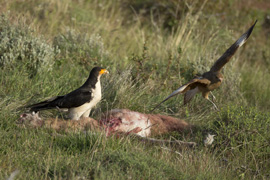
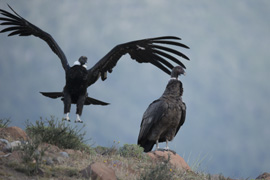
I waited over an hour until the first condors returned, flying overhead with their primaries cutting the air and making a sound that reminded me of bicycle tires when one coasts, without peddling, downhill. Once, in Calafate, Argentina, we were at a nesting colony of Condors and there, when birds passed overhead, the sound seemed more like a jet, a roaring splitting of the air. This was far less noticeable, but every time I heard it, a condor did pass overhead.
The suit worked, and condors flew in to land, but these birds are suspicious and none hopped down to the kill. An extremely rare Mountain Caracara did, and flushed off a Chimango Caracara that was the first bird to visit the kill, and strangely, the common Crested Caracara completely avoided the site. I managed several images, but it was difficult, as I had to make any movement at a snail’s pace, literally creeping along with any hand, lens, or head movement to not spook these wary birds.
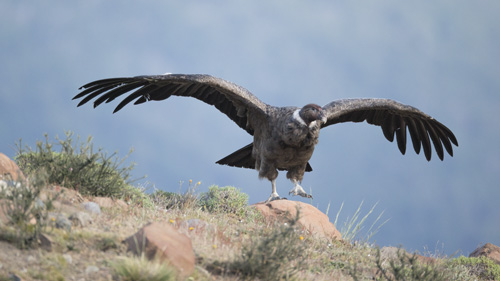
I was cold and cramping, as I settled in to my position while I was still overheated from the hikes in and out, but as I cooled off, the wind kicked up and chilled me. Fortunately for my comfort but unfortunately for my shooting, something – perhaps might movement—spooked the birds, giving me a chance to don more clothes and reposition myself, but the birds never came back. In my rush to get back under cover I quickly ate my mid-morning meal, gobbling down half a sandwich before two condors swooped low, panicking me to rush. I stuffed most of the other sandwich into my mouth as I tried to rearrange myself, and the sandwich wedged itself onto the roof of my mouth. I felt like a dog eating peanut butter, with the butter stuck and the dog’s tongue working, as I tried to dislodge the wedge and swallow! Eventually I accomplished both tasks, swallowing and resettling into the blind, and working myself into a comfortable position. Unfortunately the show seemed over, and at noon, after 5 hours basically in one cramped position and with no birds in sight, I radioed Mary to help me take down the set.
Mary, meanwhile, hiked in several likely-looking locations but did not find a puma, although she did see her first Grey Fox for our time in the park this year. Afterwards, we fortuitously met Rodrigo and Christina, and they showed us two other locations for pumas. We hiked in to the second, but found nothing, before continuing to still a third spot, where I found a recently finished and very large Guanaco kill. The three pumas at this location are extremely tame, and we hoped that our two mile hike into their territory would produce some luck in the early evening, but it didn’t.
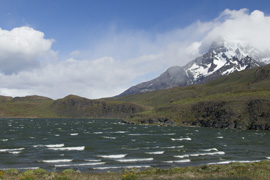
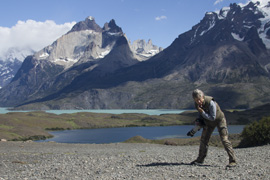
Instead, as the time neared to when we were to start our hike back a terrible wind storm developed, pummeling us and sometimes pushing along. I was wearing my Bataflae backpack with a jacket secured on the outside, giving me a top-heavy profile, and I was often quite literally pushed along with the wind, not able to hold still. Mary wore a camera fanny pack and, by hunkering low, stayed in one spot, but our walking was challenging. We suspect the winds hit 90mph, truly hurricane force, and stronger than anything either of us had ever endured. We laughed that our Antarctic katabatic winds were nothing in comparison, and in a wind like that, we’d have been marooned shore-side had one developed. It was one of the most challenging and exhausting miles we’d ever done, and as we drove home we stopped at the restaurant for the campground and rewarded ourselves with a beer.
We returned by 8:30, greeted by the tabby house cat that adopted us on our first evening at the cabin. We’ve been feeding it well, with milk or meats, and tonight, our last, we let the cat inside … and we’d have taken it home had we been able.
Day 8. Torres del Paine to Punta Arenas
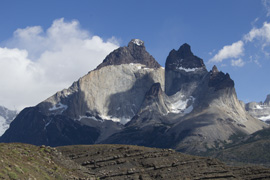 Winds and scattered rain showers marked the night, and a light coating of snow etched the ridge lines of the Horns. We slept late, although our biological clock awoke us at 3:40, almost the same time as we usually rose. After packing we planned on trying to find an Austral Pigmy Owl, but it was windy and we had no luck.
Winds and scattered rain showers marked the night, and a light coating of snow etched the ridge lines of the Horns. We slept late, although our biological clock awoke us at 3:40, almost the same time as we usually rose. After packing we planned on trying to find an Austral Pigmy Owl, but it was windy and we had no luck.
As we drove out, several condors flew low overhead by the Mirador Serrano, while to the north a misty cloud partly shrouded the mountains. The landscape was spectacular, and we stopped a few times for shots as we continued to the Park exit. We stopped when we saw some friends from the US, who informed us that some in their group had seen a puma yesterday. Their cat was near the park entrance, about a half mile beyond the spot where we had turned around to travel another road. Had we continued, we’d have had that puma, as we were there at exactly the right time.
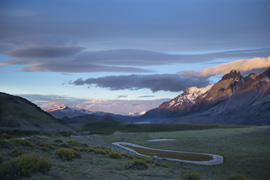 We had pumas on two days, and could have had a third had we returned the day after our first puma encounter. We’d have had a fourth had we only kept driving on the same road yesterday, which would have given us four cat days out of six. We didn’t, of course, but we were quite satisfied with the times we had and, more importantly, these encounters, or misses, simply indicated how well one can do.
We had pumas on two days, and could have had a third had we returned the day after our first puma encounter. We’d have had a fourth had we only kept driving on the same road yesterday, which would have given us four cat days out of six. We didn’t, of course, but we were quite satisfied with the times we had and, more importantly, these encounters, or misses, simply indicated how well one can do.
As we drove back to Punta Arenas we reviewed the subjects – 17 different bird species, and another 20 or so that we could have filmed had we tried, and 4 mammals, missing only the Huemel and the Gray Fox.
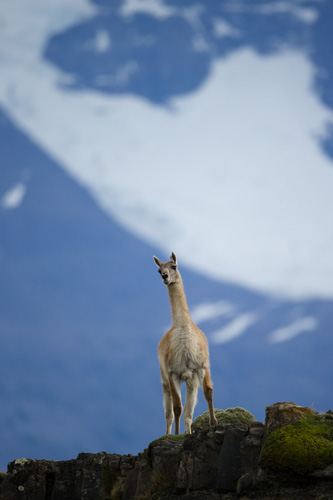
A male guanaco gazes down upon the pumas feeding at a kill, giving its wierd,
laughing whistle which serves as an alarm call for others in the herd.
If you are interested in joining us for a future Puma Quest, contact our office at info@hoothollow.com.
Quest for the Puma
aka Mountain Lion
Torres del Paine, Chile
2013 Photo Safari Scouting Trip Report
We will be offering this shoot as a
Photo Tour in December 2015 and April 2016
Contact our office for more information.

 We did it! In one calendar year, 2013, Mary and I managed to photograph all seven of the big cats. I may be wrong, but I suspect no one has ever done this in one year! Our quest for the Puma, aka mountain lion or cougar, would be the most challenging and physically demanding, and the one species we most worried about seeing or photographing. Here's the report:
We did it! In one calendar year, 2013, Mary and I managed to photograph all seven of the big cats. I may be wrong, but I suspect no one has ever done this in one year! Our quest for the Puma, aka mountain lion or cougar, would be the most challenging and physically demanding, and the one species we most worried about seeing or photographing. Here's the report:
Just three days earlier we had returned from the southern tip of South America, completing a nearly month long Ultimate Antarctica cruise. Now we were heading back, within two hundred miles of that location, as we attempted to complete a grand slam, photographing all seven of the big cats in one year. We’d started with the Snow Leopard, and having successfully accomplished that goal, we had hoped we’d get Tiger, which we did, and the others – Lion, Leopard, Cheetah, and Jaguar – would be easy. Except the Puma, the most difficult and reclusive of all the big cats.
It is tragically ironic that this, the most wide spread of all the big cats, is also the most difficult to find and photograph. Mary and I have only seen Puma, or Mountain Lion, once in the US, and that was a distant view of a mother with cubs across the Flathead River in northern Montana. I’ve seen puma tracks in southern Arizona and plenty of sign, and tracks, in the remote high country of Zion National Park in Utah, but no other cats. We’ve had puma in southern Chile before, and returning there was our best chance of photographing all seven big cats.
Packing for this expedition was a challenge. We didn’t know what to expect, whether we’d have luck encountering a puma in the field or whether we’d need to resort to camera traps, either at kills or at a cave or potential den site, or whether we’d spot a cat at night with spot lights or infrared scopes. Consequently, we carried along an enormous amount of gear.

That gear included a 20-60 Spotting Scope for scouring the cliffs for a resting puma; an FLIR thermal imaging scope with a 2X zoom feature, to spot a cat’s heat signature at night; and two spot lights, for scanning the hillsides outside the park in the predawn. We used the thermal scope a few times, actually watching three pumas moving through the low vegetation, but had we not known that we were watching cats we may not have recognized the heat signature as anything significant. The Patagonian winds were problematic, and using a high powered scope for scanning cliffs was more trouble than it was worth, and we didn’t bother. That said, however, we’d bring a scope again, just in case, or to enjoy a cat we might spot that was too far away, or inaccessible, to approach for photography.
For remote work, I brought along two Range IR infrared camera traps, two Canon 7D cameras and 28-135mm lenses, and six Vivitar 285 flashes, two Really Right Stuff ground level pods and BH25 mini-ballheads, plus 8 Phottrix flash/camera remote radio controls, and 8 threaded metal rods, all for either kills or caves. I envisioned placing a Range IR and camera system inside a cave, facing out, to photograph a cat entering, or another system at a kill, keeping the system running overnight.
Learn how to use this type of equipment in our Advanced CNPC!
All of this equipment ran on batteries, so we had duplicate lithium AA and AAA batteries for all of the gear, a total of about 80 batteries. We did find one likely looking cave that, had we set up immediately, we could have had running for a few days, but concerned that something better might happen later, we passed. We also brought along one Trail Camera, and found a likely spot to place the camera but did not, worrying we might not return to that location.
On our last day, a fresh puma kill had attracted condors, and had I not set up there myself, one of the Range IR camera systems could have been used. Instead, this kill gave me the chance to try another accessory I brought along, a sniper-like Gillie suit, a camouflaged jacket, pants, and head net that allows one to practically disappear into vegetation.
We kept all of this ‘insurance’ gear inside the vehicle so that we’d be ready should the opportunity arose, storing pieces in different bags depending upon its use. Additionally, one bag had our 550 flashes, tele-flashes, and Wimberley flash brackets, in case we worked birds in the forest. While we searched there, we did not find any Magellanic woodpeckers or owls, birds where this flash gear could have been handy.


Our shooting, then, ended up to be rather conventional. My gear consisted of an 800mm and 70-300mm with either one or two camera bodies, generally packed in a Bataflae photo backpack for more comfortable hiking. I was using a Really Right Stuff long lens support for the 800mm, a piece of equipment I find essential with this lens, although it adds another pound or so to an already heavy system. Mary’s gear included a 500mm and 28-300mm lens, although for some hikes I’d pack her 500mm and she’d use a 400mm so that we saved on weight. I had a 28-300mm along as well, in case we spent more time shooting scenic, and both of us had 16-35mm zooms, polarizers, and one Singh-Ray 9X variable neutral density filter. Both of our primary cameras had Really Right Stuff L-brackets mounted on the camera for use in vertical or horizontal modes, and the little BH25 ballheads would have accommodated this. We forgot, however, that the BH25’s used a 3/8s screw, and we didn’t bring along bushings to mount a plate that would have allowed a quick add-on to the Wimberley head. Instead, if we wanted to use the BH25s, we had to completely change heads. Because of the time spent hunting pumas, however, we rarely had a chance to use the scenic gear.
 We brought along three Garmin 630 Rino GPS systems with two-way radios. This model will register the waypoint of the other person’s location when a radio transmission occurs, allowing one to walk, via the GPS, directly to that location. In the undulating steppes, interrupted by rocky ridgelines or massive outcropping ofconglomerate rocks, we were often out of sight of one another, and had one of us seen a puma, or injured oneself, these radios would be invaluable. The voice transmission isn’t the best, however, and so we purchased two Icom Marine Radios before the trip. Despite the best of planning, some contingencies arise that were unexpected. Unfortunately, though, I only brought along one charger for the Icom radios, and assuming that like most gear today the voltage would be 120-240, I plugged in the charging unit into a 240 outlet and fried the charger. Luckily, another piece of gear had the same female plug and we could still charge, but we didn’t discover that until a few days into the trip!
We brought along three Garmin 630 Rino GPS systems with two-way radios. This model will register the waypoint of the other person’s location when a radio transmission occurs, allowing one to walk, via the GPS, directly to that location. In the undulating steppes, interrupted by rocky ridgelines or massive outcropping ofconglomerate rocks, we were often out of sight of one another, and had one of us seen a puma, or injured oneself, these radios would be invaluable. The voice transmission isn’t the best, however, and so we purchased two Icom Marine Radios before the trip. Despite the best of planning, some contingencies arise that were unexpected. Unfortunately, though, I only brought along one charger for the Icom radios, and assuming that like most gear today the voltage would be 120-240, I plugged in the charging unit into a 240 outlet and fried the charger. Luckily, another piece of gear had the same female plug and we could still charge, but we didn’t discover that until a few days into the trip!
As we packed to go home, we looked at all this gear we didn’t use, regretting in some ways that we even brought it. But had we not had the luck we eventually had, and consequently had more hours in the day to deploy the gear, and more motivation or desperation to use it, we were covered.

If our posture looks odd, its because we're leaning into a 40mph wind. One day, after hiking out 2 miles on a beautifully calm afternoon, the weather changed and we struggled back to the car in winds that may have reached 90mph! I was literally pushed dozens of yards across the grassland!
Clothing was another concern. While it was technically late spring or early summer, with their summer solstice just two weeks away, Torres del Paine can be cold, especially when there is a wind. And there almost always is a wind. On any given day we could have sun, wind, rain, wind, sun, and calm conditions, all within a few hours. Layering clothing was the best bet, and we always started the morning with three layers on our legs, with two pairs of varying weight long underwear, and camouflaged pants, and on top, four or five layers, starting with ‘next to skin’ long underwear, followed by another long sleeved tee-shirt, camouflaged shirt, wool sweater, and vest. In the field, we’d wear a medium weight camouflaged jacket over that.
Additionally, there were several different hats, wide-brimmed and ball caps for sun, wool caps for cold, and neck warmers, gloves, and mittens, for driving in the predawn. Mid-day we’d often still wear a light pair of wool gloves for some protection from the chill winds. We wore boots daily, with good ankle support for negotiating across the rocky slopes.
Mid-day, if the wind dissipated, we might be down to just pants, two layers on top, and a jacket, but we almost always carried a down jacket in our packs in case the weather changed, along with rain pants for blocking the wind or for sitting down on damp ground, or for rain, should it occur. Sitting at one location for hours, we’d often go through several clothing changes, shedding or donning layers as the weather changed.
Day 1. Arrival in Torres del Paine

Partial sunlight and broken clouds hovering near the three great granite mastiffs of the Towers of Torres del Paine had me second-guessing as we unpacked and rested after driving all day, in preparation for a long day tomorrow. Were we wasting good light, or good weather, and simply being lazy?
We left our hotel at 9AM this morning, after an overnight flight and a day spent traveling down the spine of the Andes yesterday. It had been several years since we’ve made this fly-over and watching the scars of retreated glaciers, I regretted not having photos or a better memory – were the glaciers that far back ten years ago? Many glaciers were obviously in retreat, but as we traveled further south enormous ice fields covered the mountains from one peak to another, and the Puerto Moreno Glacier still crept down to create its usual bottle-neck at Lagos Argentina.
Subduction of the Pacific plate created the Andes, as that tectonic plate slid beneath the continent of South America. The stress of this has caused the Andes, and the volcanoes that periodically poked above the clouds. Recent volcanoes, they are covered in snow and so perfectly formed they are the exact copy of any kid’s drawing, a perfect, white-capped, conical peak.
Concerned about our mileage and gas, we lingered at Sona Franca, a huge complex of specialty stores, where we spied plastic and metal gas cans. We purchased two plastic cans, giving us an extra 30 liters of gas, and as it turns out we’ll probably need it. Our lodging is a comfortable little cabin at Hosteria Tyndall, along the shores of the Rio Serrano, but unfortunately this position puts us about 50 kilometers, or a 1.5 hour drive, from the area we normally drive to hunt for pumas. As we headed to our cabin we were struck by the size of the park – we didn’t remember this long of a drive, and we worried that our cabin and the hotel complex would be accessible only by ferry. Years ago, we’d checked out this lodge when, in fact, there was no road access, and the only way in was by a ferry which would not be operating at 4AM when we started our drives.
Fortunately a road now leads to the Serrano Hotel complex and to Tyndall, along a recently cut road where, as we ascended, an Andean Condor descended, flying over the road and into the valley. On our drive north we’d seen over a dozen condors, the first one I almost mistook for a small plane. They are big birds! Several of the dozen or so we saw hung in the wind, and Mary could see the white ruff-like collar that distinctly marks this bird. Brown-hooded Gulls, Buff-necked Ibis, Kelp Gulls, Crested Caracaras, and the pink dots of Chilean Flamingos marked our drive, along with one Patagonian Gray Fox that trotted across the road and along the berm for a short while.
Unpacking took over an hour, as we sorted the equipment we might need if we set up an infra-red system at a carcass, the gear we’d carry afield, and the cameras and lenses we’d use for traditional photography when we were not searching for  pumas. I was a bit worried that our luggage might be inspected on the way in, as we looked like we were more spies than photographers, having a rag-like, bushy Gillie suit, which I hoped to use as a blind if we worked a kill; a thermal-imaging scope that I received, via a UPS drop-off station, the day we left the US; three Rhino GPS units, in order to locate each other, and perhaps a friend, if we separated to search; and two new Icom two-way Radios for better communication. This along with a 20-60X spotting scope, more camou, two huge telephotos, and six different radio-triggered flash/camera transmitters and receivers, and two pairs of binoculars – an 18X IS version, and a standard 10X. I do not think we looked like the average tourist visiting TdP!
pumas. I was a bit worried that our luggage might be inspected on the way in, as we looked like we were more spies than photographers, having a rag-like, bushy Gillie suit, which I hoped to use as a blind if we worked a kill; a thermal-imaging scope that I received, via a UPS drop-off station, the day we left the US; three Rhino GPS units, in order to locate each other, and perhaps a friend, if we separated to search; and two new Icom two-way Radios for better communication. This along with a 20-60X spotting scope, more camou, two huge telephotos, and six different radio-triggered flash/camera transmitters and receivers, and two pairs of binoculars – an 18X IS version, and a standard 10X. I do not think we looked like the average tourist visiting TdP!
What we hoped would be a favorable omen appeared as we walked the hundred yards to our cabin. A friendly, and beautiful, tabby House Cat ran up to us and, as cats often will do, ingratiated itself with us. We were seduced immediately.
 Day 2. Wind. We awoke at 3:15AM and the Towers were framed by a field of brilliant stars. By 3:50 we were on the road, and arrived at our scouting area just as the skies began to lighten, making the use of the expensive thermal imaging scope unnecessary. Guanacos were whistling an alarm, a good sign that a puma had been sighted, but we couldn’t spot the cat. The skies were spectacular, however, and diverted our attention as we photographed the incredible lenticular clouds, glowing orange and yellow, in a very heavy wind.
Day 2. Wind. We awoke at 3:15AM and the Towers were framed by a field of brilliant stars. By 3:50 we were on the road, and arrived at our scouting area just as the skies began to lighten, making the use of the expensive thermal imaging scope unnecessary. Guanacos were whistling an alarm, a good sign that a puma had been sighted, but we couldn’t spot the cat. The skies were spectacular, however, and diverted our attention as we photographed the incredible lenticular clouds, glowing orange and yellow, in a very heavy wind.
The wind never abated, and when we finally decided to go cross-country on foot the wind was sometimes so intense that we were, without exaggeration, blown sideways or pushed forward. Coscoroba Swans, stout, short-necked birds that resemble geese more than a graceful swan, took flight when we neared their pond and several of the birds, facing into the wind, literally hung in the air, making no forward progress against the gale. Chilean Flamingos and other swans were smarter and simply flew the lake, with the wind, where they landed far on the opposite bank.
 We checked multiple cliffs and ridges, but in the wind every bend was an ordeal as we were simply pummeled by the blasts. At 11 we found a quiet spot and snoozed for an hour or two before continuing our search. We saw no cats.
We checked multiple cliffs and ridges, but in the wind every bend was an ordeal as we were simply pummeled by the blasts. At 11 we found a quiet spot and snoozed for an hour or two before continuing our search. We saw no cats.
In mid-afternoon we investigated an area where a stone hide, or blind, had been erected, probably for condor photography. We located a few spots where a Trailcam might be useful, but saw no definitive signs of a puma.
When we returned to our car a group of Guanacos, the southern Andes version of the camel, had gathered near the road. Mary was going to take some shots but the guanacos were doing nothing, and I almost dissuaded her from shooting. Instead, we decided to just hang out and watch, and enjoy the guanacos and see what they would do.
The herd accepted us, and as they got up from resting positions most moved closer. One female caught our attention, as she appeared heavy and swollen, as if she was about to give birth. She got up and switched position several times, usually moving closer when she did so. As we watched, we saw that she was beginning to drip, as if her water had broken, and as she moved about she eventually settled nearby, but behind some screening brush.
She rose, and the hooves of her baby were visible. Over the next half hour she periodically lay down or stood, and the head and forelegs of the baby appeared. Mary was using a 500mm and had nearly perfect framing, while I was using an 800, much too big a lens for the distance we were working, and I switched to a 70-300 as the guanaco rose, rotated in a half circle, and dropped the baby, practically in
front of us and in perfect view.
Almost immediately, several members of the herd gathered to inspect the newborn, and as the baby finally got to its feet it almost imprinted on one guanaco that stayed by the mother the entire time after the birth. As that guanaco moved off the baby attempted to follow, but the female would try to get in front, blocking the baby’s progress, although the baby tried hard to keep up with the wrong mother. Eventually that guanaco moved off and the baby settled with its true mother, who proceeded to either graze or chew its cud while the baby slowly gathered its legs and balance and began searching for a teat.


It took a surprisingly long time for the baby to finally nurse, but soon after that action triggered the female into expelling the afterbirth, a bulbous mass and nearly three foot long string of tissue. During the entire time the female never groomed or licked her baby, whose curly, matted fur eventually began to dry and frizz. Other babies were now fully fuzzy, and we suspect they had been born earlier in the day. Some other females looked as if their birthing was imminent, but judging by what we’d just seen not within the next few hours. We suspect that they might give birth tomorrow.
 While we were considering leaving, a Hognose Skunk, with an usual tan-brown back, appeared. When it tried to cross the road several guanacos took chase, following it closely as it ran into the brush. None of the guanacos tried to kick or stamp the skunk, who eventually settled next to one of the likely-looking pregnant guanacos, where the skunk dug for grubs unmolested, just a few yards from the guanaco.
While we were considering leaving, a Hognose Skunk, with an usual tan-brown back, appeared. When it tried to cross the road several guanacos took chase, following it closely as it ran into the brush. None of the guanacos tried to kick or stamp the skunk, who eventually settled next to one of the likely-looking pregnant guanacos, where the skunk dug for grubs unmolested, just a few yards from the guanaco.
We headed back to our cabin, an hour drive in beautiful light, tempting us with scenic but with another early start planned, we wisely headed home, where downloading still awaited.
 Day 3. We left at 4:20 this morning, for after speaking with our friend Diego, we were advised to patrol for pumas at first light, and not predawn as we had been accustomed. By 5:15 we were in our area, stopping for a few minutes to speak with Diego before we continued. His group had a scout car that took a different road, and as it turned out, had action.
Day 3. We left at 4:20 this morning, for after speaking with our friend Diego, we were advised to patrol for pumas at first light, and not predawn as we had been accustomed. By 5:15 we were in our area, stopping for a few minutes to speak with Diego before we continued. His group had a scout car that took a different road, and as it turned out, had action.
Meanwhile, we followed the same route as yesterday, and I half-expected to find pumas on a fresh quanaco kill, perhaps even one of the babies we photographed yesterday afternoon. We did not find a kill, and all of the guanacos in the area were settled and relaxed, without any alarm calls. Near the end of our intended route we did find an immature Andean Condor and a Crested Caracara perched on a rock outcrop close to the road, which made us suspicious, but we found nothing. The condor cooperated, however, allowing the closest approach I’ve ever had with this bird.
Mary worked on the spring Orchids, with one species resembling a Moccasin Flower from home, with a deep yellow scalloped petal. When she finished we continued on to the puma cliffs, and although I was tempted to stop and hike because of the amazing lack of wind, Mary suggested we continue and do the lake where, along the shoreline, caves sometimes shelter pumas.
As we descended the plateau we passed our friend’s vehicle and a short distance beyond saw Diego and his group along a small lake shore. No one was photographing, and we almost drove on, but since we knew that caracaras sometimes nested there, we stopped to ask what they were shooting. Diego’s shocking reply, three pumas!
We had hoped to find a puma on our own, a personal, perhaps pig-headed challenge, but we knew that on any given day the likelihood of finding another cat was extremely slim. We asked if it would be okay to join in and received permission, with the caveat that this was ‘their’ puma and Diego would call the shots. If we found the cat first, we’d have the same privilege, which are the basic operating rules we try to work out when we’re dealing with people in crowded Yellowstone. Sometimes it works there, and sometimes it doesn’t, but here the system generally works quite well.
I’ve known Diego for over ten years, meeting him for the first time when Mary and I did our first solo trip to the area, hoping to see pumas. Dressed in dusty camouflage clothes, Diego sauntered down the road, stopping to say hello and to ask what we were doing. He recognized kindred spirits, of course, as we were dressed in camou as well. Somewhat guardedly, we exchanged some information about what we were doing, and Diego shared that he had helped some major film crews find pumas. He offered to help us, but we declined, as we stubbornly hoped to find a cat ourselves.
That evening, Diego found a mother puma with two cubs, and stayed with them until he was walking the steppes in almost complete darkness. The small video camera he was using functioned almost like a night scope, allowing him to see the cats where, with his naked eye, they were invisible. As darkness fell the cats became more and more inquisitive, running close by as they played, and he worried that things might get out of hand. Ten years ago, puma habituation was still in its infancy, and Diego as one of the pioneers was still amassing experience.
Two days later, on one of the winding roads we met Diego again where he showed us his video. We had a strong opinion of him then, and welcomed any help we could receive. We didn’t find another puma on that trip but on future visits we always made arrangements to meet up. Diego was with clients this time, but he invited us to join him if he spotted a cat and we accepted.
We unloaded our cameras, tripods, and backpacks, and Mary stayed by the road while Diego hopped into my car and directed me to a distant spot to park. Many tours hunt for cars, he explained, and a cluster of cars might attract a crowd of tourists that could impact upon our puma watching. We found a spot a half mile down the road.
When we arrived back, Mary was already on site, along with my gear, carried by one of Diego’s spotters. Diego had come a long way since we first met, and now owned three vehicles, camping equipment, and employed two spotters to assist in finding cats. Rodrigo has been Diego’s best friend since college, where they both studied marine biology. Rod is a skilled photographer himself, one of Chile’s best known wildlife photographers, and one of his images of a puma caught the attention of a girl. A veterinarian, Christina, was so moved by the beauty of the image that she wanted to meet this photographer, and later, in researching to take her first photography class, she learned Rod was the best. Eventually, Christina left veterinary medicine and became a guide in Torres del Paine, and where, just ten days earlier, she found Rod’s hidden engagement ring tucked in a hollow of a limestone cliff. The two would be married next year.
It was now nearly 7 or 7:30 when we arrived on site, to discover that a mother Puma and her two cubs had killed, and had been feeding upon, a guanaco only about 50 yards off the road. By the time we arrived the cats had retreated to a small thicket, composed of willows and leafy shrubs that lined the grass and reed-lined shoreline of the lake. The cats were hidden, and having fed, we knew we’d have had absolutely no chance of spotting them had we not seen our friend.
 Over the next hour or so the cats periodically raised their heads from the brush, and one of the young climbed one of the willow trees, ascending into the lower branches before jumping off and disappearing once more into the vegetation. By 10 the action had stopped, and our friends headed back to their hotel for showers and downloading, planning to return by 5PM when the cats might resume their activity.
Over the next hour or so the cats periodically raised their heads from the brush, and one of the young climbed one of the willow trees, ascending into the lower branches before jumping off and disappearing once more into the vegetation. By 10 the action had stopped, and our friends headed back to their hotel for showers and downloading, planning to return by 5PM when the cats might resume their activity.
For Mary and I, three hidden cats in the bush were worth … well, anything, since we had come to photograph pumas and cats were there, albeit hidden right now. Diego and his two scouts, Christina and Rod, believed the cats would wake up at some point and perhaps play, and although a lot of down time would be involved they thought we would get something.
And so we waited. While we did so, we discovered that the pumas had actually killed two guanacos during the night, an adult, which they had been feeding upon, and a newborn, or chalingo, that they had abandoned. An Andean Condor eventually discovered the kill and visited, dropping out of the sky with set, motionless wings and feet hanging low, but each visit was brief, and the huge bird  looked nervous. A Crested Caracara perched on a tree close to us, and tolerated a close approach, and various birds, Negritos, Thrushes, and Sparrows, offered some diversion as the hours passed.
looked nervous. A Crested Caracara perched on a tree close to us, and tolerated a close approach, and various birds, Negritos, Thrushes, and Sparrows, offered some diversion as the hours passed.
At one point, two male Guanacos, in a serious fight, came charging past us, dropping over the bank and directly into the brush where the three pumas lay. One awoke, and charged the guanacos, but the puma was one of the cubs, although nearly full-grown, and I suspect the charge was as much play as anything. It missed, of course, and the cats settled down again after giving us a few quick shots as they moved through openings and back into the brush.
One of the two cubs was tailless, with only the merest nub of a tail, which may have been a birth defect and not an accident, as the cub was tailless from the first time it was spotted, only a few months old. Most tailless or partially bobbed cats lose their tails in fights, or, at least in Africa, in run-ins with hyenas, but no predator other than a male puma could account for this, and a male puma would have surely killed the cub if it bothered to even maim it.

A large herd of guanacos gathered in the field adjacent to the woodlot, about 75 yards from where the cats were sleeping. New born calves accompanied their mothers into this pasture, and adults sparred and mated, but the cats showed little interest. Eventually, however, two male guanacos got into a serious fight, racing about as one chased the other, attempting to castrate its rival when it neared. Guanaco fights involve rearing, kicking, and a lot of screaming, and all of this activity finally awakened the interest of the tailless puma. It appeared at the edge of the brush, watching, and, finally, too teased by the proximity of prey, the puma charged the guanacos.
They had seen it coming and merely ran off, with plenty of alarm whistles, a hoarse laughing cascade. The cat returned to cover, but the session was good, and we felt that the wait had been worthwhile. The racket, however, had attracted the mother, which we hadn’t seen, and now in the brush less than thirty yards away from where we sat, three pumas lay hidden.


 About 5 our friends returned, and soon after the two cubs awoke and began to play, racing around the brush, jumping, and occasionally wrestling with one another. Over the next two hours the cats continued to show themselves, playing, chasing, climbing trees, wrestling with each other, giving us an incredible show. At one point, when we had all moved to a different vantage, one of the cubs walked up to where Mary and I had laid our Bataflae backpacks and our lunches, and we were afraid that the cat would either destroy or run off with something. Instead, it merely sniffed and continued on, walking quite close to us as it dropped back to the playing field.
About 5 our friends returned, and soon after the two cubs awoke and began to play, racing around the brush, jumping, and occasionally wrestling with one another. Over the next two hours the cats continued to show themselves, playing, chasing, climbing trees, wrestling with each other, giving us an incredible show. At one point, when we had all moved to a different vantage, one of the cubs walked up to where Mary and I had laid our Bataflae backpacks and our lunches, and we were afraid that the cat would either destroy or run off with something. Instead, it merely sniffed and continued on, walking quite close to us as it dropped back to the playing field.
By 7:30 the cats appeared to be interested in their kill, and most of us headed uphill to overlook the carcass. Mary stayed behind, not wishing to add to the small crowd – the six of us in the group. Both cubs soon appeared, feeding unconcernedly in the falling light. I did mostly video, although eventually I switched back to film. Meanwhile, the female stayed behind at the thicket, where she called and meowed and chirped, eventually drawing the two cubs back.

While Mary waited she photographed the mother licking and grooming the bloody muzzle of the tailless cub, and photographed the two wrestling and playing. Later, the tailless cub walked almost directly to Mary, stopping so close that the puma’s head literally filled her frame! The second cub was following the other, but the tailless cub attacked, initiating another play fight which carried them off into the brush.
It had begun to rain lightly, and the light was failing, and concerned that the mother may be holding back to feed after we’d gone, we stopped the shoot and headed back to our vehicles. At times we were with 30 feet or so of the cats, or they to us, as we never approached them but instead their own curiosity and playfulness brought them so close. In all, Mary and I had spent 13 hours in the company of these cats, and while they were often hidden, we were within forty yards as they slept, and this, after they had approached the thicket close to us to do so.
We arrived back at our cabin by 10PM, celebrating one of the most satisfying and successful field days we’ve ever had. Clouds shrouded the Torres mastiff, and still having nearly 1.5 hours of downloading and cleaning to do, we decided to sleep in tomorrow, and work on other subjects once we started the day.

The tailless cub wrestles with her mother. Although the cub is only 9 months old,
she is 2/3rds the size of the mother, and looks like an adult.








If you'd like to get the latest information on our trips, especially new trips or
unexpected openings, sign up! We do not share our email list with anyone.
Day 4. We didn’t get to bed until midnight, caught up with a quick, preliminary review of the nearly 2,000 images each of us shot yesterday. Although we awoke at 4, 5, and 7, we managed to roll over and fall back to sleep, until finally, at 11AM we pulled ourselves out of bed. Almost an 11 hour sleep, and as our energy level showed throughout the day, it still didn’t seem to be enough. We were in second gear all day.
Mary cooked a hearty brunch of chorizo sausage, toast, and fried eggs, and by 1PM we finally left our cabin. Our intentions were to explore the Lago Gray area for Huemel, the southern South American deer that resembles a whitetail in many ways, Magellanic Woodpeckers, one of the world’s largest species, and Torrent Ducks, the South American ecological equivalent of an American Merganser or Harlequin Duck, as this species inhabits fast mountain rapids. We found none of the above.
 Instead, on our drive in Mary spotted a beautiful Black-chested Buzzard Eagle, a large, gray colored raptor fairly close to the road. Mary made some shots out of the car window before I tried sneaking out and shooting with my 800mm from the roof top. Both worked well. Later, as we neared the park area, we spotted a Blackish Rail strutting about on the berm. This long-billed dark gray rail closely resembled its Pantanal relative, the Wood-Rail, and acted similarly, darting into vegetation and disappearing easily. I shot some mediocre frames as it ran across the road but had much better luck when it unexpectedly appeared in a small clearing, just outside the minimum focus of my lens, for very nice images.
Instead, on our drive in Mary spotted a beautiful Black-chested Buzzard Eagle, a large, gray colored raptor fairly close to the road. Mary made some shots out of the car window before I tried sneaking out and shooting with my 800mm from the roof top. Both worked well. Later, as we neared the park area, we spotted a Blackish Rail strutting about on the berm. This long-billed dark gray rail closely resembled its Pantanal relative, the Wood-Rail, and acted similarly, darting into vegetation and disappearing easily. I shot some mediocre frames as it ran across the road but had much better luck when it unexpectedly appeared in a small clearing, just outside the minimum focus of my lens, for very nice images.
 At Lago Gray, where the Gray’s Glacier has well sculpted icebergs stranded along the broad beach, we searched for our target species without success. I did some back-country hiking to look for the Huemel, and perhaps because it was a still, relatively warm day, or more likely, my butt was simply dragging after the last two days, I was soaked with sweat after the hike. We had intended to drive back to the puma area and be there by 5, but it was 5 before we even reached the crossroads where we’d turn for another hour’s drive, and our gas tank was reading only 1/3 full. Worried about the gas situation we headed to park headquarters where we learned that a local in the settlement where we were staying sold gas, and we filled up there. It began to rain, and our intention to hunt for pigmy owls dissolved in the rain and instead Mary warmed over our spaghetti dinner from our first evening as we drank wine and, at only 8PM, looked forward to a good night’s sleep.
At Lago Gray, where the Gray’s Glacier has well sculpted icebergs stranded along the broad beach, we searched for our target species without success. I did some back-country hiking to look for the Huemel, and perhaps because it was a still, relatively warm day, or more likely, my butt was simply dragging after the last two days, I was soaked with sweat after the hike. We had intended to drive back to the puma area and be there by 5, but it was 5 before we even reached the crossroads where we’d turn for another hour’s drive, and our gas tank was reading only 1/3 full. Worried about the gas situation we headed to park headquarters where we learned that a local in the settlement where we were staying sold gas, and we filled up there. It began to rain, and our intention to hunt for pigmy owls dissolved in the rain and instead Mary warmed over our spaghetti dinner from our first evening as we drank wine and, at only 8PM, looked forward to a good night’s sleep.
Day 5. Another early start, rising at 3:30AM and out the door by 4:15 as we headed to the pumas once again, hoping that they’d still be at the kill. En route we met Rodrigo and Christina, Diego’s scouts, who were headed in the same direction and where we learned that the pumas performed well last evening, although the light was poor. We’d looked to the east and had figured they’d have rain, and with the gas situation decided against the trip. Now feeling refreshed after a relaxing day yesterday, we did not regret our decision.
 The pumas were just leaving the kill when we arrived, with the mother and the two cubs slowly walking up hill to a small forest. Rodrigo and Christina were packed and ready to go and began following the cats, while Mary and I repackaged our long lenses into our Bataflae bags for an uphill hike of unknown length or duration. Fortunately, the cats settled down at the first woods, where they lay in the open in beautiful low grass.
The pumas were just leaving the kill when we arrived, with the mother and the two cubs slowly walking up hill to a small forest. Rodrigo and Christina were packed and ready to go and began following the cats, while Mary and I repackaged our long lenses into our Bataflae bags for an uphill hike of unknown length or duration. Fortunately, the cats settled down at the first woods, where they lay in the open in beautiful low grass.
The cats were a bit more sedate, moving about and chasing one another for a few times. The mother disappeared into the forest where she slept, while the tailless cub attempted a stalk of a couple of guanacos on the upper slope. She squirmed and reset her hindquarters as if to charge but the guanacos never came close and eventually she lost interest and she headed into a lower section of forest.
I was busy chatting with Diego while most of the group moved lower to watch for the cub. Two guanaco males were fighting and in the chase that usually results one ran close to the lower woods where the tailless cat had emerged, and was now lying flat in the low growth only fifteen meters from the unsuspecting guanaco. At about that time we realized something was happening and scrambled down with our gear, but the guanaco had taken off and, to everyone’s surprise, the puma didn’t even move.
We’ve seen this type of unexpected behavior many times with many cats, where the prey seemed so close that a chase or kill seemed inevitable. In this case, an adult male guanaco was far too big for the nine month old cub to kill, but a chase, or even a jump onto its back, was possible. It didn’t happen.
Soon after all three cats retreated to the nearest forest, about sixty yards from our position, where they remained until 5:30PM. Mary and I remained behind, figuring that three cats in the bush beat anything else, and perhaps a chalingo, a baby guanaco, might wander by. So we waited, in perhaps the most pleasant afternoon we’ve had, sunny and so warm we stripped down to our thinnest layers. A Cinnerous Marsh Hawk sailed by on teetering wings several times, flaring its tail and swooping at the trees, hunting for birds. One condor flew overhead, but never circled to investigate the baby guanaco yesterday’s condor fed upon, or the adult guanaco carcass.



All of our exposures were shot in Manual Mode, Spot Metering. Although we had brought along flashes, camera traps, etc. we ended up not needing this equipment. However, if you'd like to master photography skills, or learn all you'll need to know about flash, camera remotes, and more, check out our Digital Complete Nature Photo Course or our Advanced (Flash) DCNPC.
At 5:30 the rest of our friends arrived, and within minutes the two puma cubs emerged from the forest. We were expecting play behavior, but after a few chases both cats headed toward the kill. Fortunately they paused several times, affording wonderful shots, although I missed a dream shot, where the puma, full-frame in a vertical format, was walking toward me! My Wimberley knobs were locked tight, and by the time I loosened the knobs and repositioned the cat had moved. The pose lasted only seconds, but I missed it.
Nonetheless, the two cubs presented several wonderful views as they lay on the trail before us, or looked around bushes, or walked so close that the cats were head shots with my big lens. They walked directly to the kill which was far below  us from our present position. Both cats fed for a short time, then moved further downhill, appearing to be heading to the small lake where our encounters began two days ago. Vehicles driving up the road stopped their progress, and both cats hunkered down. The tailed cub returned to the kill, just as we were calling it a day, but we dropped down to a lower level where Mary and I filmed and shot the cat as it fed, played on the carcass, dragged it, and shook the neck of the guanaco. Eventually it headed off and we continued downhill.
us from our present position. Both cats fed for a short time, then moved further downhill, appearing to be heading to the small lake where our encounters began two days ago. Vehicles driving up the road stopped their progress, and both cats hunkered down. The tailed cub returned to the kill, just as we were calling it a day, but we dropped down to a lower level where Mary and I filmed and shot the cat as it fed, played on the carcass, dragged it, and shook the neck of the guanaco. Eventually it headed off and we continued downhill.

Check out our Trip Reports for the stories behind our other Big Cat adventures.
At 8PM we headed home, stopping en route when Mary spotted a chick riding amongst the feathers of one of the parent Black-necked Swans feeding close to the road. We stopped, but by the time Mary could dig out her lens and brace it on the window frame of our car, just seconds too late, the chick dropped off the adult. We still photographed the birds quite close, but the magical shot was gone. We continued home, arriving at our cabin at 9PM.

 Day 6. We were on our own today, without the benefit of other scout cars and without a known kill where pumas were likely to be. We drove along all the likely locations, leaving our cabin at 4:20AM and arriving on site around 5:10. After our first run we stopped to shoot the Horns and Towers in a mediocre sunrise, fighting hurricane force winds as we did so. We continued on towards the condor blind area, where the guanacos had given birth three days ago. Although we planned on hiking out to the Castle, the winds were a gale, and instead we settled down for a nap, which began at 7AM and ended at 10AM! When we awoke, the guanacos were before us, and a van-load of tourists were outside, aiming their cameras at a guanaco. I commented that perhaps it was giving birth, and indeed it was!
Day 6. We were on our own today, without the benefit of other scout cars and without a known kill where pumas were likely to be. We drove along all the likely locations, leaving our cabin at 4:20AM and arriving on site around 5:10. After our first run we stopped to shoot the Horns and Towers in a mediocre sunrise, fighting hurricane force winds as we did so. We continued on towards the condor blind area, where the guanacos had given birth three days ago. Although we planned on hiking out to the Castle, the winds were a gale, and instead we settled down for a nap, which began at 7AM and ended at 10AM! When we awoke, the guanacos were before us, and a van-load of tourists were outside, aiming their cameras at a guanaco. I commented that perhaps it was giving birth, and indeed it was!
 We awoke just as the baby’s head and forelegs were emerging, and the mother circling constantly in one spot as she pushed out the baby. I shot the entire sequence with a 70-300mm, and Mary backed up for her 500mm. After the birth, the baby finally gained its footing at 30 minutes, and kept upright from that point on. We continued down to the Laguna Amarga Gate, where we photographed the Towers and some guanacos that waded in the river.
We awoke just as the baby’s head and forelegs were emerging, and the mother circling constantly in one spot as she pushed out the baby. I shot the entire sequence with a 70-300mm, and Mary backed up for her 500mm. After the birth, the baby finally gained its footing at 30 minutes, and kept upright from that point on. We continued down to the Laguna Amarga Gate, where we photographed the Towers and some guanacos that waded in the river.
Returning to puma country, we hiked in towards the Castle, but we had only two hours before we were to meet Rod and Christina and travel in tandem with them to Lago Azul, where we hoped to film Silver Grebes. The Castle search was unproductive, although Mary found some cliffs with caves that she felt were very promising and deserving another look tomorrow.
Christina and Rod were late, so we continued on, stopping at the Cascades where, against another gale, we shot a scenic of the rapids and the Towers, and continued on to Azul. Huge herds of guanacos lined the way, and we were told that a female Puma with four large young hunted that game-rich area.
 The Silver Grebe marsh was ideal, with birds nesting on low clumps of vegetation they had dragged up and built a floating nest. We were concerned that we might spook the birds, so we approached carefully, and I literally crawled the last several yards for a ground- or water-level perspective. The birds remained on their nest.
The Silver Grebe marsh was ideal, with birds nesting on low clumps of vegetation they had dragged up and built a floating nest. We were concerned that we might spook the birds, so we approached carefully, and I literally crawled the last several yards for a ground- or water-level perspective. The birds remained on their nest.
We were hoping to photograph adults with chicks riding on their backs and we had several opportunities to do so. With one chick riding one adult, the other constantly dove and captured some aquatic insect, with a rapidity and consistency that was amazing. Every dive produced a tidbit, and most dives were incredibly short. One larger chick had  hopped off the adult and later attempted to reclaim its position, squirming in and comically kicking with its webbed feet to push itself into the feathers.
hopped off the adult and later attempted to reclaim its position, squirming in and comically kicking with its webbed feet to push itself into the feathers.
The Silver Grebe is a striking bird with vivid red eyes and a flare of yellow feathers passing behind its ears. Young birds were striped, red-eyed, and snake-like, and the chick would reach out, snatching the offering from the other adult in moves almost too quick to frame. Christina and Rod arrived late, and they walked upright and close, with the birds never deserting the nests. Rod said they never do, and even adults with chicks swam close-by, which we found remarkable.

We left after 7:30 when our other friends arrived, wishing to shoot in ‘better light’ although clouds now hung threatening against the western horizon. Although it was after 8:30, we decided to scout out the entire area for pumas before heading home. We had no luck, and in a driving wind arrived back at our cabin at 10:04PM, the latest yet, giving us too few hours of sleep for tomorrow, our last day.
 Day 7. We didn’t get to bed until midnight, and rising at 3:30AM was difficult. Wind shook our small cabin, so conditions didn’t look promising, and sleeping in was a temptation we found hard to avoid. We did, however, and were on the road at 4:18, reaching the puma area by 5:15. The Towers and Horns were beautiful, bathed in a soft orange light, but we were focused on finding pumas and ignored the landscapes. Both roads offered nothing, but near our turn-around point we spotted Andean Condors dropping from the sky. I walked out to investigate, getting quite close to the birds before they took off. They were watching, and perhaps feeding upon, a young Guanaco puma kill, with the bloody throat from the cat’s hold, and the rib cage exposed and eaten, a certain mark for a puma in South America.
Day 7. We didn’t get to bed until midnight, and rising at 3:30AM was difficult. Wind shook our small cabin, so conditions didn’t look promising, and sleeping in was a temptation we found hard to avoid. We did, however, and were on the road at 4:18, reaching the puma area by 5:15. The Towers and Horns were beautiful, bathed in a soft orange light, but we were focused on finding pumas and ignored the landscapes. Both roads offered nothing, but near our turn-around point we spotted Andean Condors dropping from the sky. I walked out to investigate, getting quite close to the birds before they took off. They were watching, and perhaps feeding upon, a young Guanaco puma kill, with the bloody throat from the cat’s hold, and the rib cage exposed and eaten, a certain mark for a puma in South America.
Rather than hike for pumas, I donned the Gillie suit I’d brought along just for this purpose and settled down in the almost barren landscape, looking as much as a bush as I could. Gillie suits, used by snipers in the military, are composed of green and yellow fibrous strands that give a 3-dimensional aspect to camouflage, and in the right setting allows one to completely disappear. I had no low brush to merge with, but still, from the location of the kill Mary said I looked like a bush, with only the lens and tripod exposed in a non-gillie camou.


I waited over an hour until the first condors returned, flying overhead with their primaries cutting the air and making a sound that reminded me of bicycle tires when one coasts, without peddling, downhill. Once, in Calafate, Argentina, we were at a nesting colony of Condors and there, when birds passed overhead, the sound seemed more like a jet, a roaring splitting of the air. This was far less noticeable, but every time I heard it, a condor did pass overhead.
The suit worked, and condors flew in to land, but these birds are suspicious and none hopped down to the kill. An extremely rare Mountain Caracara did, and flushed off a Chimango Caracara that was the first bird to visit the kill, and strangely, the common Crested Caracara completely avoided the site. I managed several images, but it was difficult, as I had to make any movement at a snail’s pace, literally creeping along with any hand, lens, or head movement to not spook these wary birds.

I was cold and cramping, as I settled in to my position while I was still overheated from the hikes in and out, but as I cooled off, the wind kicked up and chilled me. Fortunately for my comfort but unfortunately for my shooting, something – perhaps might movement—spooked the birds, giving me a chance to don more clothes and reposition myself, but the birds never came back. In my rush to get back under cover I quickly ate my mid-morning meal, gobbling down half a sandwich before two condors swooped low, panicking me to rush. I stuffed most of the other sandwich into my mouth as I tried to rearrange myself, and the sandwich wedged itself onto the roof of my mouth. I felt like a dog eating peanut butter, with the butter stuck and the dog’s tongue working, as I tried to dislodge the wedge and swallow! Eventually I accomplished both tasks, swallowing and resettling into the blind, and working myself into a comfortable position. Unfortunately the show seemed over, and at noon, after 5 hours basically in one cramped position and with no birds in sight, I radioed Mary to help me take down the set.
Mary, meanwhile, hiked in several likely-looking locations but did not find a puma, although she did see her first Grey Fox for our time in the park this year. Afterwards, we fortuitously met Rodrigo and Christina, and they showed us two other locations for pumas. We hiked in to the second, but found nothing, before continuing to still a third spot, where I found a recently finished and very large Guanaco kill. The three pumas at this location are extremely tame, and we hoped that our two mile hike into their territory would produce some luck in the early evening, but it didn’t.


Instead, as the time neared to when we were to start our hike back a terrible wind storm developed, pummeling us and sometimes pushing along. I was wearing my Bataflae backpack with a jacket secured on the outside, giving me a top-heavy profile, and I was often quite literally pushed along with the wind, not able to hold still. Mary wore a camera fanny pack and, by hunkering low, stayed in one spot, but our walking was challenging. We suspect the winds hit 90mph, truly hurricane force, and stronger than anything either of us had ever endured. We laughed that our Antarctic katabatic winds were nothing in comparison, and in a wind like that, we’d have been marooned shore-side had one developed. It was one of the most challenging and exhausting miles we’d ever done, and as we drove home we stopped at the restaurant for the campground and rewarded ourselves with a beer.
We returned by 8:30, greeted by the tabby house cat that adopted us on our first evening at the cabin. We’ve been feeding it well, with milk or meats, and tonight, our last, we let the cat inside … and we’d have taken it home had we been able.
Day 8. Torres del Paine to Punta Arenas
 Winds and scattered rain showers marked the night, and a light coating of snow etched the ridge lines of the Horns. We slept late, although our biological clock awoke us at 3:40, almost the same time as we usually rose. After packing we planned on trying to find an Austral Pigmy Owl, but it was windy and we had no luck.
Winds and scattered rain showers marked the night, and a light coating of snow etched the ridge lines of the Horns. We slept late, although our biological clock awoke us at 3:40, almost the same time as we usually rose. After packing we planned on trying to find an Austral Pigmy Owl, but it was windy and we had no luck.
As we drove out, several condors flew low overhead by the Mirador Serrano, while to the north a misty cloud partly shrouded the mountains. The landscape was spectacular, and we stopped a few times for shots as we continued to the Park exit. We stopped when we saw some friends from the US, who informed us that some in their group had seen a puma yesterday. Their cat was near the park entrance, about a half mile beyond the spot where we had turned around to travel another road. Had we continued, we’d have had that puma, as we were there at exactly the right time.
 We had pumas on two days, and could have had a third had we returned the day after our first puma encounter. We’d have had a fourth had we only kept driving on the same road yesterday, which would have given us four cat days out of six. We didn’t, of course, but we were quite satisfied with the times we had and, more importantly, these encounters, or misses, simply indicated how well one can do.
We had pumas on two days, and could have had a third had we returned the day after our first puma encounter. We’d have had a fourth had we only kept driving on the same road yesterday, which would have given us four cat days out of six. We didn’t, of course, but we were quite satisfied with the times we had and, more importantly, these encounters, or misses, simply indicated how well one can do.
As we drove back to Punta Arenas we reviewed the subjects – 17 different bird species, and another 20 or so that we could have filmed had we tried, and 4 mammals, missing only the Huemel and the Gray Fox.

A male guanaco gazes down upon the pumas feeding at a kill, giving its wierd,
laughing whistle which serves as an alarm call for others in the herd.
If you are interested in joining us for a future Puma Quest, contact our office at info@hoothollow.com.
Quest for the Puma
aka Mountain Lion
Torres del Paine, Chile
2013 Photo Safari Scouting Trip Report
We will be offering this shoot as a
Photo Tour in December 2015 and April 2016
Contact our office for more information.

 We did it! In one calendar year, 2013, Mary and I managed to photograph all seven of the big cats. I may be wrong, but I suspect no one has ever done this in one year! Our quest for the Puma, aka mountain lion or cougar, would be the most challenging and physically demanding, and the one species we most worried about seeing or photographing. Here's the report:
We did it! In one calendar year, 2013, Mary and I managed to photograph all seven of the big cats. I may be wrong, but I suspect no one has ever done this in one year! Our quest for the Puma, aka mountain lion or cougar, would be the most challenging and physically demanding, and the one species we most worried about seeing or photographing. Here's the report:
Just three days earlier we had returned from the southern tip of South America, completing a nearly month long Ultimate Antarctica cruise. Now we were heading back, within two hundred miles of that location, as we attempted to complete a grand slam, photographing all seven of the big cats in one year. We’d started with the Snow Leopard, and having successfully accomplished that goal, we had hoped we’d get Tiger, which we did, and the others – Lion, Leopard, Cheetah, and Jaguar – would be easy. Except the Puma, the most difficult and reclusive of all the big cats.
It is tragically ironic that this, the most wide spread of all the big cats, is also the most difficult to find and photograph. Mary and I have only seen Puma, or Mountain Lion, once in the US, and that was a distant view of a mother with cubs across the Flathead River in northern Montana. I’ve seen puma tracks in southern Arizona and plenty of sign, and tracks, in the remote high country of Zion National Park in Utah, but no other cats. We’ve had puma in southern Chile before, and returning there was our best chance of photographing all seven big cats.
Packing for this expedition was a challenge. We didn’t know what to expect, whether we’d have luck encountering a puma in the field or whether we’d need to resort to camera traps, either at kills or at a cave or potential den site, or whether we’d spot a cat at night with spot lights or infrared scopes. Consequently, we carried along an enormous amount of gear.

That gear included a 20-60 Spotting Scope for scouring the cliffs for a resting puma; an FLIR thermal imaging scope with a 2X zoom feature, to spot a cat’s heat signature at night; and two spot lights, for scanning the hillsides outside the park in the predawn. We used the thermal scope a few times, actually watching three pumas moving through the low vegetation, but had we not known that we were watching cats we may not have recognized the heat signature as anything significant. The Patagonian winds were problematic, and using a high powered scope for scanning cliffs was more trouble than it was worth, and we didn’t bother. That said, however, we’d bring a scope again, just in case, or to enjoy a cat we might spot that was too far away, or inaccessible, to approach for photography.
For remote work, I brought along two Range IR infrared camera traps, two Canon 7D cameras and 28-135mm lenses, and six Vivitar 285 flashes, two Really Right Stuff ground level pods and BH25 mini-ballheads, plus 8 Phottrix flash/camera remote radio controls, and 8 threaded metal rods, all for either kills or caves. I envisioned placing a Range IR and camera system inside a cave, facing out, to photograph a cat entering, or another system at a kill, keeping the system running overnight.
Learn how to use this type of equipment in our Advanced CNPC!
All of this equipment ran on batteries, so we had duplicate lithium AA and AAA batteries for all of the gear, a total of about 80 batteries. We did find one likely looking cave that, had we set up immediately, we could have had running for a few days, but concerned that something better might happen later, we passed. We also brought along one Trail Camera, and found a likely spot to place the camera but did not, worrying we might not return to that location.
On our last day, a fresh puma kill had attracted condors, and had I not set up there myself, one of the Range IR camera systems could have been used. Instead, this kill gave me the chance to try another accessory I brought along, a sniper-like Gillie suit, a camouflaged jacket, pants, and head net that allows one to practically disappear into vegetation.
We kept all of this ‘insurance’ gear inside the vehicle so that we’d be ready should the opportunity arose, storing pieces in different bags depending upon its use. Additionally, one bag had our 550 flashes, tele-flashes, and Wimberley flash brackets, in case we worked birds in the forest. While we searched there, we did not find any Magellanic woodpeckers or owls, birds where this flash gear could have been handy.


Our shooting, then, ended up to be rather conventional. My gear consisted of an 800mm and 70-300mm with either one or two camera bodies, generally packed in a Bataflae photo backpack for more comfortable hiking. I was using a Really Right Stuff long lens support for the 800mm, a piece of equipment I find essential with this lens, although it adds another pound or so to an already heavy system. Mary’s gear included a 500mm and 28-300mm lens, although for some hikes I’d pack her 500mm and she’d use a 400mm so that we saved on weight. I had a 28-300mm along as well, in case we spent more time shooting scenic, and both of us had 16-35mm zooms, polarizers, and one Singh-Ray 9X variable neutral density filter. Both of our primary cameras had Really Right Stuff L-brackets mounted on the camera for use in vertical or horizontal modes, and the little BH25 ballheads would have accommodated this. We forgot, however, that the BH25’s used a 3/8s screw, and we didn’t bring along bushings to mount a plate that would have allowed a quick add-on to the Wimberley head. Instead, if we wanted to use the BH25s, we had to completely change heads. Because of the time spent hunting pumas, however, we rarely had a chance to use the scenic gear.
 We brought along three Garmin 630 Rino GPS systems with two-way radios. This model will register the waypoint of the other person’s location when a radio transmission occurs, allowing one to walk, via the GPS, directly to that location. In the undulating steppes, interrupted by rocky ridgelines or massive outcropping ofconglomerate rocks, we were often out of sight of one another, and had one of us seen a puma, or injured oneself, these radios would be invaluable. The voice transmission isn’t the best, however, and so we purchased two Icom Marine Radios before the trip. Despite the best of planning, some contingencies arise that were unexpected. Unfortunately, though, I only brought along one charger for the Icom radios, and assuming that like most gear today the voltage would be 120-240, I plugged in the charging unit into a 240 outlet and fried the charger. Luckily, another piece of gear had the same female plug and we could still charge, but we didn’t discover that until a few days into the trip!
We brought along three Garmin 630 Rino GPS systems with two-way radios. This model will register the waypoint of the other person’s location when a radio transmission occurs, allowing one to walk, via the GPS, directly to that location. In the undulating steppes, interrupted by rocky ridgelines or massive outcropping ofconglomerate rocks, we were often out of sight of one another, and had one of us seen a puma, or injured oneself, these radios would be invaluable. The voice transmission isn’t the best, however, and so we purchased two Icom Marine Radios before the trip. Despite the best of planning, some contingencies arise that were unexpected. Unfortunately, though, I only brought along one charger for the Icom radios, and assuming that like most gear today the voltage would be 120-240, I plugged in the charging unit into a 240 outlet and fried the charger. Luckily, another piece of gear had the same female plug and we could still charge, but we didn’t discover that until a few days into the trip!
As we packed to go home, we looked at all this gear we didn’t use, regretting in some ways that we even brought it. But had we not had the luck we eventually had, and consequently had more hours in the day to deploy the gear, and more motivation or desperation to use it, we were covered.

If our posture looks odd, its because we're leaning into a 40mph wind. One day, after hiking out 2 miles on a beautifully calm afternoon, the weather changed and we struggled back to the car in winds that may have reached 90mph! I was literally pushed dozens of yards across the grassland!
Clothing was another concern. While it was technically late spring or early summer, with their summer solstice just two weeks away, Torres del Paine can be cold, especially when there is a wind. And there almost always is a wind. On any given day we could have sun, wind, rain, wind, sun, and calm conditions, all within a few hours. Layering clothing was the best bet, and we always started the morning with three layers on our legs, with two pairs of varying weight long underwear, and camouflaged pants, and on top, four or five layers, starting with ‘next to skin’ long underwear, followed by another long sleeved tee-shirt, camouflaged shirt, wool sweater, and vest. In the field, we’d wear a medium weight camouflaged jacket over that.
Additionally, there were several different hats, wide-brimmed and ball caps for sun, wool caps for cold, and neck warmers, gloves, and mittens, for driving in the predawn. Mid-day we’d often still wear a light pair of wool gloves for some protection from the chill winds. We wore boots daily, with good ankle support for negotiating across the rocky slopes.
Mid-day, if the wind dissipated, we might be down to just pants, two layers on top, and a jacket, but we almost always carried a down jacket in our packs in case the weather changed, along with rain pants for blocking the wind or for sitting down on damp ground, or for rain, should it occur. Sitting at one location for hours, we’d often go through several clothing changes, shedding or donning layers as the weather changed.
Day 1. Arrival in Torres del Paine

Partial sunlight and broken clouds hovering near the three great granite mastiffs of the Towers of Torres del Paine had me second-guessing as we unpacked and rested after driving all day, in preparation for a long day tomorrow. Were we wasting good light, or good weather, and simply being lazy?
We left our hotel at 9AM this morning, after an overnight flight and a day spent traveling down the spine of the Andes yesterday. It had been several years since we’ve made this fly-over and watching the scars of retreated glaciers, I regretted not having photos or a better memory – were the glaciers that far back ten years ago? Many glaciers were obviously in retreat, but as we traveled further south enormous ice fields covered the mountains from one peak to another, and the Puerto Moreno Glacier still crept down to create its usual bottle-neck at Lagos Argentina.
Subduction of the Pacific plate created the Andes, as that tectonic plate slid beneath the continent of South America. The stress of this has caused the Andes, and the volcanoes that periodically poked above the clouds. Recent volcanoes, they are covered in snow and so perfectly formed they are the exact copy of any kid’s drawing, a perfect, white-capped, conical peak.
Concerned about our mileage and gas, we lingered at Sona Franca, a huge complex of specialty stores, where we spied plastic and metal gas cans. We purchased two plastic cans, giving us an extra 30 liters of gas, and as it turns out we’ll probably need it. Our lodging is a comfortable little cabin at Hosteria Tyndall, along the shores of the Rio Serrano, but unfortunately this position puts us about 50 kilometers, or a 1.5 hour drive, from the area we normally drive to hunt for pumas. As we headed to our cabin we were struck by the size of the park – we didn’t remember this long of a drive, and we worried that our cabin and the hotel complex would be accessible only by ferry. Years ago, we’d checked out this lodge when, in fact, there was no road access, and the only way in was by a ferry which would not be operating at 4AM when we started our drives.
Fortunately a road now leads to the Serrano Hotel complex and to Tyndall, along a recently cut road where, as we ascended, an Andean Condor descended, flying over the road and into the valley. On our drive north we’d seen over a dozen condors, the first one I almost mistook for a small plane. They are big birds! Several of the dozen or so we saw hung in the wind, and Mary could see the white ruff-like collar that distinctly marks this bird. Brown-hooded Gulls, Buff-necked Ibis, Kelp Gulls, Crested Caracaras, and the pink dots of Chilean Flamingos marked our drive, along with one Patagonian Gray Fox that trotted across the road and along the berm for a short while.
Unpacking took over an hour, as we sorted the equipment we might need if we set up an infra-red system at a carcass, the gear we’d carry afield, and the cameras and lenses we’d use for traditional photography when we were not searching for  pumas. I was a bit worried that our luggage might be inspected on the way in, as we looked like we were more spies than photographers, having a rag-like, bushy Gillie suit, which I hoped to use as a blind if we worked a kill; a thermal-imaging scope that I received, via a UPS drop-off station, the day we left the US; three Rhino GPS units, in order to locate each other, and perhaps a friend, if we separated to search; and two new Icom two-way Radios for better communication. This along with a 20-60X spotting scope, more camou, two huge telephotos, and six different radio-triggered flash/camera transmitters and receivers, and two pairs of binoculars – an 18X IS version, and a standard 10X. I do not think we looked like the average tourist visiting TdP!
pumas. I was a bit worried that our luggage might be inspected on the way in, as we looked like we were more spies than photographers, having a rag-like, bushy Gillie suit, which I hoped to use as a blind if we worked a kill; a thermal-imaging scope that I received, via a UPS drop-off station, the day we left the US; three Rhino GPS units, in order to locate each other, and perhaps a friend, if we separated to search; and two new Icom two-way Radios for better communication. This along with a 20-60X spotting scope, more camou, two huge telephotos, and six different radio-triggered flash/camera transmitters and receivers, and two pairs of binoculars – an 18X IS version, and a standard 10X. I do not think we looked like the average tourist visiting TdP!
What we hoped would be a favorable omen appeared as we walked the hundred yards to our cabin. A friendly, and beautiful, tabby House Cat ran up to us and, as cats often will do, ingratiated itself with us. We were seduced immediately.
 Day 2. Wind. We awoke at 3:15AM and the Towers were framed by a field of brilliant stars. By 3:50 we were on the road, and arrived at our scouting area just as the skies began to lighten, making the use of the expensive thermal imaging scope unnecessary. Guanacos were whistling an alarm, a good sign that a puma had been sighted, but we couldn’t spot the cat. The skies were spectacular, however, and diverted our attention as we photographed the incredible lenticular clouds, glowing orange and yellow, in a very heavy wind.
Day 2. Wind. We awoke at 3:15AM and the Towers were framed by a field of brilliant stars. By 3:50 we were on the road, and arrived at our scouting area just as the skies began to lighten, making the use of the expensive thermal imaging scope unnecessary. Guanacos were whistling an alarm, a good sign that a puma had been sighted, but we couldn’t spot the cat. The skies were spectacular, however, and diverted our attention as we photographed the incredible lenticular clouds, glowing orange and yellow, in a very heavy wind.
The wind never abated, and when we finally decided to go cross-country on foot the wind was sometimes so intense that we were, without exaggeration, blown sideways or pushed forward. Coscoroba Swans, stout, short-necked birds that resemble geese more than a graceful swan, took flight when we neared their pond and several of the birds, facing into the wind, literally hung in the air, making no forward progress against the gale. Chilean Flamingos and other swans were smarter and simply flew the lake, with the wind, where they landed far on the opposite bank.
 We checked multiple cliffs and ridges, but in the wind every bend was an ordeal as we were simply pummeled by the blasts. At 11 we found a quiet spot and snoozed for an hour or two before continuing our search. We saw no cats.
We checked multiple cliffs and ridges, but in the wind every bend was an ordeal as we were simply pummeled by the blasts. At 11 we found a quiet spot and snoozed for an hour or two before continuing our search. We saw no cats.
In mid-afternoon we investigated an area where a stone hide, or blind, had been erected, probably for condor photography. We located a few spots where a Trailcam might be useful, but saw no definitive signs of a puma.
When we returned to our car a group of Guanacos, the southern Andes version of the camel, had gathered near the road. Mary was going to take some shots but the guanacos were doing nothing, and I almost dissuaded her from shooting. Instead, we decided to just hang out and watch, and enjoy the guanacos and see what they would do.
The herd accepted us, and as they got up from resting positions most moved closer. One female caught our attention, as she appeared heavy and swollen, as if she was about to give birth. She got up and switched position several times, usually moving closer when she did so. As we watched, we saw that she was beginning to drip, as if her water had broken, and as she moved about she eventually settled nearby, but behind some screening brush.
She rose, and the hooves of her baby were visible. Over the next half hour she periodically lay down or stood, and the head and forelegs of the baby appeared. Mary was using a 500mm and had nearly perfect framing, while I was using an 800, much too big a lens for the distance we were working, and I switched to a 70-300 as the guanaco rose, rotated in a half circle, and dropped the baby, practically in
front of us and in perfect view.
Almost immediately, several members of the herd gathered to inspect the newborn, and as the baby finally got to its feet it almost imprinted on one guanaco that stayed by the mother the entire time after the birth. As that guanaco moved off the baby attempted to follow, but the female would try to get in front, blocking the baby’s progress, although the baby tried hard to keep up with the wrong mother. Eventually that guanaco moved off and the baby settled with its true mother, who proceeded to either graze or chew its cud while the baby slowly gathered its legs and balance and began searching for a teat.


It took a surprisingly long time for the baby to finally nurse, but soon after that action triggered the female into expelling the afterbirth, a bulbous mass and nearly three foot long string of tissue. During the entire time the female never groomed or licked her baby, whose curly, matted fur eventually began to dry and frizz. Other babies were now fully fuzzy, and we suspect they had been born earlier in the day. Some other females looked as if their birthing was imminent, but judging by what we’d just seen not within the next few hours. We suspect that they might give birth tomorrow.
 While we were considering leaving, a Hognose Skunk, with an usual tan-brown back, appeared. When it tried to cross the road several guanacos took chase, following it closely as it ran into the brush. None of the guanacos tried to kick or stamp the skunk, who eventually settled next to one of the likely-looking pregnant guanacos, where the skunk dug for grubs unmolested, just a few yards from the guanaco.
While we were considering leaving, a Hognose Skunk, with an usual tan-brown back, appeared. When it tried to cross the road several guanacos took chase, following it closely as it ran into the brush. None of the guanacos tried to kick or stamp the skunk, who eventually settled next to one of the likely-looking pregnant guanacos, where the skunk dug for grubs unmolested, just a few yards from the guanaco.
We headed back to our cabin, an hour drive in beautiful light, tempting us with scenic but with another early start planned, we wisely headed home, where downloading still awaited.
 Day 3. We left at 4:20 this morning, for after speaking with our friend Diego, we were advised to patrol for pumas at first light, and not predawn as we had been accustomed. By 5:15 we were in our area, stopping for a few minutes to speak with Diego before we continued. His group had a scout car that took a different road, and as it turned out, had action.
Day 3. We left at 4:20 this morning, for after speaking with our friend Diego, we were advised to patrol for pumas at first light, and not predawn as we had been accustomed. By 5:15 we were in our area, stopping for a few minutes to speak with Diego before we continued. His group had a scout car that took a different road, and as it turned out, had action.
Meanwhile, we followed the same route as yesterday, and I half-expected to find pumas on a fresh quanaco kill, perhaps even one of the babies we photographed yesterday afternoon. We did not find a kill, and all of the guanacos in the area were settled and relaxed, without any alarm calls. Near the end of our intended route we did find an immature Andean Condor and a Crested Caracara perched on a rock outcrop close to the road, which made us suspicious, but we found nothing. The condor cooperated, however, allowing the closest approach I’ve ever had with this bird.
Mary worked on the spring Orchids, with one species resembling a Moccasin Flower from home, with a deep yellow scalloped petal. When she finished we continued on to the puma cliffs, and although I was tempted to stop and hike because of the amazing lack of wind, Mary suggested we continue and do the lake where, along the shoreline, caves sometimes shelter pumas.
As we descended the plateau we passed our friend’s vehicle and a short distance beyond saw Diego and his group along a small lake shore. No one was photographing, and we almost drove on, but since we knew that caracaras sometimes nested there, we stopped to ask what they were shooting. Diego’s shocking reply, three pumas!
We had hoped to find a puma on our own, a personal, perhaps pig-headed challenge, but we knew that on any given day the likelihood of finding another cat was extremely slim. We asked if it would be okay to join in and received permission, with the caveat that this was ‘their’ puma and Diego would call the shots. If we found the cat first, we’d have the same privilege, which are the basic operating rules we try to work out when we’re dealing with people in crowded Yellowstone. Sometimes it works there, and sometimes it doesn’t, but here the system generally works quite well.
I’ve known Diego for over ten years, meeting him for the first time when Mary and I did our first solo trip to the area, hoping to see pumas. Dressed in dusty camouflage clothes, Diego sauntered down the road, stopping to say hello and to ask what we were doing. He recognized kindred spirits, of course, as we were dressed in camou as well. Somewhat guardedly, we exchanged some information about what we were doing, and Diego shared that he had helped some major film crews find pumas. He offered to help us, but we declined, as we stubbornly hoped to find a cat ourselves.
That evening, Diego found a mother puma with two cubs, and stayed with them until he was walking the steppes in almost complete darkness. The small video camera he was using functioned almost like a night scope, allowing him to see the cats where, with his naked eye, they were invisible. As darkness fell the cats became more and more inquisitive, running close by as they played, and he worried that things might get out of hand. Ten years ago, puma habituation was still in its infancy, and Diego as one of the pioneers was still amassing experience.
Two days later, on one of the winding roads we met Diego again where he showed us his video. We had a strong opinion of him then, and welcomed any help we could receive. We didn’t find another puma on that trip but on future visits we always made arrangements to meet up. Diego was with clients this time, but he invited us to join him if he spotted a cat and we accepted.
We unloaded our cameras, tripods, and backpacks, and Mary stayed by the road while Diego hopped into my car and directed me to a distant spot to park. Many tours hunt for cars, he explained, and a cluster of cars might attract a crowd of tourists that could impact upon our puma watching. We found a spot a half mile down the road.
When we arrived back, Mary was already on site, along with my gear, carried by one of Diego’s spotters. Diego had come a long way since we first met, and now owned three vehicles, camping equipment, and employed two spotters to assist in finding cats. Rodrigo has been Diego’s best friend since college, where they both studied marine biology. Rod is a skilled photographer himself, one of Chile’s best known wildlife photographers, and one of his images of a puma caught the attention of a girl. A veterinarian, Christina, was so moved by the beauty of the image that she wanted to meet this photographer, and later, in researching to take her first photography class, she learned Rod was the best. Eventually, Christina left veterinary medicine and became a guide in Torres del Paine, and where, just ten days earlier, she found Rod’s hidden engagement ring tucked in a hollow of a limestone cliff. The two would be married next year.
It was now nearly 7 or 7:30 when we arrived on site, to discover that a mother Puma and her two cubs had killed, and had been feeding upon, a guanaco only about 50 yards off the road. By the time we arrived the cats had retreated to a small thicket, composed of willows and leafy shrubs that lined the grass and reed-lined shoreline of the lake. The cats were hidden, and having fed, we knew we’d have had absolutely no chance of spotting them had we not seen our friend.
 Over the next hour or so the cats periodically raised their heads from the brush, and one of the young climbed one of the willow trees, ascending into the lower branches before jumping off and disappearing once more into the vegetation. By 10 the action had stopped, and our friends headed back to their hotel for showers and downloading, planning to return by 5PM when the cats might resume their activity.
Over the next hour or so the cats periodically raised their heads from the brush, and one of the young climbed one of the willow trees, ascending into the lower branches before jumping off and disappearing once more into the vegetation. By 10 the action had stopped, and our friends headed back to their hotel for showers and downloading, planning to return by 5PM when the cats might resume their activity.
For Mary and I, three hidden cats in the bush were worth … well, anything, since we had come to photograph pumas and cats were there, albeit hidden right now. Diego and his two scouts, Christina and Rod, believed the cats would wake up at some point and perhaps play, and although a lot of down time would be involved they thought we would get something.
And so we waited. While we did so, we discovered that the pumas had actually killed two guanacos during the night, an adult, which they had been feeding upon, and a newborn, or chalingo, that they had abandoned. An Andean Condor eventually discovered the kill and visited, dropping out of the sky with set, motionless wings and feet hanging low, but each visit was brief, and the huge bird  looked nervous. A Crested Caracara perched on a tree close to us, and tolerated a close approach, and various birds, Negritos, Thrushes, and Sparrows, offered some diversion as the hours passed.
looked nervous. A Crested Caracara perched on a tree close to us, and tolerated a close approach, and various birds, Negritos, Thrushes, and Sparrows, offered some diversion as the hours passed.
At one point, two male Guanacos, in a serious fight, came charging past us, dropping over the bank and directly into the brush where the three pumas lay. One awoke, and charged the guanacos, but the puma was one of the cubs, although nearly full-grown, and I suspect the charge was as much play as anything. It missed, of course, and the cats settled down again after giving us a few quick shots as they moved through openings and back into the brush.
One of the two cubs was tailless, with only the merest nub of a tail, which may have been a birth defect and not an accident, as the cub was tailless from the first time it was spotted, only a few months old. Most tailless or partially bobbed cats lose their tails in fights, or, at least in Africa, in run-ins with hyenas, but no predator other than a male puma could account for this, and a male puma would have surely killed the cub if it bothered to even maim it.

A large herd of guanacos gathered in the field adjacent to the woodlot, about 75 yards from where the cats were sleeping. New born calves accompanied their mothers into this pasture, and adults sparred and mated, but the cats showed little interest. Eventually, however, two male guanacos got into a serious fight, racing about as one chased the other, attempting to castrate its rival when it neared. Guanaco fights involve rearing, kicking, and a lot of screaming, and all of this activity finally awakened the interest of the tailless puma. It appeared at the edge of the brush, watching, and, finally, too teased by the proximity of prey, the puma charged the guanacos.
They had seen it coming and merely ran off, with plenty of alarm whistles, a hoarse laughing cascade. The cat returned to cover, but the session was good, and we felt that the wait had been worthwhile. The racket, however, had attracted the mother, which we hadn’t seen, and now in the brush less than thirty yards away from where we sat, three pumas lay hidden.


 About 5 our friends returned, and soon after the two cubs awoke and began to play, racing around the brush, jumping, and occasionally wrestling with one another. Over the next two hours the cats continued to show themselves, playing, chasing, climbing trees, wrestling with each other, giving us an incredible show. At one point, when we had all moved to a different vantage, one of the cubs walked up to where Mary and I had laid our Bataflae backpacks and our lunches, and we were afraid that the cat would either destroy or run off with something. Instead, it merely sniffed and continued on, walking quite close to us as it dropped back to the playing field.
About 5 our friends returned, and soon after the two cubs awoke and began to play, racing around the brush, jumping, and occasionally wrestling with one another. Over the next two hours the cats continued to show themselves, playing, chasing, climbing trees, wrestling with each other, giving us an incredible show. At one point, when we had all moved to a different vantage, one of the cubs walked up to where Mary and I had laid our Bataflae backpacks and our lunches, and we were afraid that the cat would either destroy or run off with something. Instead, it merely sniffed and continued on, walking quite close to us as it dropped back to the playing field.
By 7:30 the cats appeared to be interested in their kill, and most of us headed uphill to overlook the carcass. Mary stayed behind, not wishing to add to the small crowd – the six of us in the group. Both cubs soon appeared, feeding unconcernedly in the falling light. I did mostly video, although eventually I switched back to film. Meanwhile, the female stayed behind at the thicket, where she called and meowed and chirped, eventually drawing the two cubs back.

While Mary waited she photographed the mother licking and grooming the bloody muzzle of the tailless cub, and photographed the two wrestling and playing. Later, the tailless cub walked almost directly to Mary, stopping so close that the puma’s head literally filled her frame! The second cub was following the other, but the tailless cub attacked, initiating another play fight which carried them off into the brush.
It had begun to rain lightly, and the light was failing, and concerned that the mother may be holding back to feed after we’d gone, we stopped the shoot and headed back to our vehicles. At times we were with 30 feet or so of the cats, or they to us, as we never approached them but instead their own curiosity and playfulness brought them so close. In all, Mary and I had spent 13 hours in the company of these cats, and while they were often hidden, we were within forty yards as they slept, and this, after they had approached the thicket close to us to do so.
We arrived back at our cabin by 10PM, celebrating one of the most satisfying and successful field days we’ve ever had. Clouds shrouded the Torres mastiff, and still having nearly 1.5 hours of downloading and cleaning to do, we decided to sleep in tomorrow, and work on other subjects once we started the day.

The tailless cub wrestles with her mother. Although the cub is only 9 months old,
she is 2/3rds the size of the mother, and looks like an adult.








If you'd like to get the latest information on our trips, especially new trips or
unexpected openings, sign up! We do not share our email list with anyone.
Day 4. We didn’t get to bed until midnight, caught up with a quick, preliminary review of the nearly 2,000 images each of us shot yesterday. Although we awoke at 4, 5, and 7, we managed to roll over and fall back to sleep, until finally, at 11AM we pulled ourselves out of bed. Almost an 11 hour sleep, and as our energy level showed throughout the day, it still didn’t seem to be enough. We were in second gear all day.
Mary cooked a hearty brunch of chorizo sausage, toast, and fried eggs, and by 1PM we finally left our cabin. Our intentions were to explore the Lago Gray area for Huemel, the southern South American deer that resembles a whitetail in many ways, Magellanic Woodpeckers, one of the world’s largest species, and Torrent Ducks, the South American ecological equivalent of an American Merganser or Harlequin Duck, as this species inhabits fast mountain rapids. We found none of the above.
 Instead, on our drive in Mary spotted a beautiful Black-chested Buzzard Eagle, a large, gray colored raptor fairly close to the road. Mary made some shots out of the car window before I tried sneaking out and shooting with my 800mm from the roof top. Both worked well. Later, as we neared the park area, we spotted a Blackish Rail strutting about on the berm. This long-billed dark gray rail closely resembled its Pantanal relative, the Wood-Rail, and acted similarly, darting into vegetation and disappearing easily. I shot some mediocre frames as it ran across the road but had much better luck when it unexpectedly appeared in a small clearing, just outside the minimum focus of my lens, for very nice images.
Instead, on our drive in Mary spotted a beautiful Black-chested Buzzard Eagle, a large, gray colored raptor fairly close to the road. Mary made some shots out of the car window before I tried sneaking out and shooting with my 800mm from the roof top. Both worked well. Later, as we neared the park area, we spotted a Blackish Rail strutting about on the berm. This long-billed dark gray rail closely resembled its Pantanal relative, the Wood-Rail, and acted similarly, darting into vegetation and disappearing easily. I shot some mediocre frames as it ran across the road but had much better luck when it unexpectedly appeared in a small clearing, just outside the minimum focus of my lens, for very nice images.
 At Lago Gray, where the Gray’s Glacier has well sculpted icebergs stranded along the broad beach, we searched for our target species without success. I did some back-country hiking to look for the Huemel, and perhaps because it was a still, relatively warm day, or more likely, my butt was simply dragging after the last two days, I was soaked with sweat after the hike. We had intended to drive back to the puma area and be there by 5, but it was 5 before we even reached the crossroads where we’d turn for another hour’s drive, and our gas tank was reading only 1/3 full. Worried about the gas situation we headed to park headquarters where we learned that a local in the settlement where we were staying sold gas, and we filled up there. It began to rain, and our intention to hunt for pigmy owls dissolved in the rain and instead Mary warmed over our spaghetti dinner from our first evening as we drank wine and, at only 8PM, looked forward to a good night’s sleep.
At Lago Gray, where the Gray’s Glacier has well sculpted icebergs stranded along the broad beach, we searched for our target species without success. I did some back-country hiking to look for the Huemel, and perhaps because it was a still, relatively warm day, or more likely, my butt was simply dragging after the last two days, I was soaked with sweat after the hike. We had intended to drive back to the puma area and be there by 5, but it was 5 before we even reached the crossroads where we’d turn for another hour’s drive, and our gas tank was reading only 1/3 full. Worried about the gas situation we headed to park headquarters where we learned that a local in the settlement where we were staying sold gas, and we filled up there. It began to rain, and our intention to hunt for pigmy owls dissolved in the rain and instead Mary warmed over our spaghetti dinner from our first evening as we drank wine and, at only 8PM, looked forward to a good night’s sleep.
Day 5. Another early start, rising at 3:30AM and out the door by 4:15 as we headed to the pumas once again, hoping that they’d still be at the kill. En route we met Rodrigo and Christina, Diego’s scouts, who were headed in the same direction and where we learned that the pumas performed well last evening, although the light was poor. We’d looked to the east and had figured they’d have rain, and with the gas situation decided against the trip. Now feeling refreshed after a relaxing day yesterday, we did not regret our decision.
 The pumas were just leaving the kill when we arrived, with the mother and the two cubs slowly walking up hill to a small forest. Rodrigo and Christina were packed and ready to go and began following the cats, while Mary and I repackaged our long lenses into our Bataflae bags for an uphill hike of unknown length or duration. Fortunately, the cats settled down at the first woods, where they lay in the open in beautiful low grass.
The pumas were just leaving the kill when we arrived, with the mother and the two cubs slowly walking up hill to a small forest. Rodrigo and Christina were packed and ready to go and began following the cats, while Mary and I repackaged our long lenses into our Bataflae bags for an uphill hike of unknown length or duration. Fortunately, the cats settled down at the first woods, where they lay in the open in beautiful low grass.
The cats were a bit more sedate, moving about and chasing one another for a few times. The mother disappeared into the forest where she slept, while the tailless cub attempted a stalk of a couple of guanacos on the upper slope. She squirmed and reset her hindquarters as if to charge but the guanacos never came close and eventually she lost interest and she headed into a lower section of forest.
I was busy chatting with Diego while most of the group moved lower to watch for the cub. Two guanaco males were fighting and in the chase that usually results one ran close to the lower woods where the tailless cat had emerged, and was now lying flat in the low growth only fifteen meters from the unsuspecting guanaco. At about that time we realized something was happening and scrambled down with our gear, but the guanaco had taken off and, to everyone’s surprise, the puma didn’t even move.
We’ve seen this type of unexpected behavior many times with many cats, where the prey seemed so close that a chase or kill seemed inevitable. In this case, an adult male guanaco was far too big for the nine month old cub to kill, but a chase, or even a jump onto its back, was possible. It didn’t happen.
Soon after all three cats retreated to the nearest forest, about sixty yards from our position, where they remained until 5:30PM. Mary and I remained behind, figuring that three cats in the bush beat anything else, and perhaps a chalingo, a baby guanaco, might wander by. So we waited, in perhaps the most pleasant afternoon we’ve had, sunny and so warm we stripped down to our thinnest layers. A Cinnerous Marsh Hawk sailed by on teetering wings several times, flaring its tail and swooping at the trees, hunting for birds. One condor flew overhead, but never circled to investigate the baby guanaco yesterday’s condor fed upon, or the adult guanaco carcass.



All of our exposures were shot in Manual Mode, Spot Metering. Although we had brought along flashes, camera traps, etc. we ended up not needing this equipment. However, if you'd like to master photography skills, or learn all you'll need to know about flash, camera remotes, and more, check out our Digital Complete Nature Photo Course or our Advanced (Flash) DCNPC.
At 5:30 the rest of our friends arrived, and within minutes the two puma cubs emerged from the forest. We were expecting play behavior, but after a few chases both cats headed toward the kill. Fortunately they paused several times, affording wonderful shots, although I missed a dream shot, where the puma, full-frame in a vertical format, was walking toward me! My Wimberley knobs were locked tight, and by the time I loosened the knobs and repositioned the cat had moved. The pose lasted only seconds, but I missed it.
Nonetheless, the two cubs presented several wonderful views as they lay on the trail before us, or looked around bushes, or walked so close that the cats were head shots with my big lens. They walked directly to the kill which was far below  us from our present position. Both cats fed for a short time, then moved further downhill, appearing to be heading to the small lake where our encounters began two days ago. Vehicles driving up the road stopped their progress, and both cats hunkered down. The tailed cub returned to the kill, just as we were calling it a day, but we dropped down to a lower level where Mary and I filmed and shot the cat as it fed, played on the carcass, dragged it, and shook the neck of the guanaco. Eventually it headed off and we continued downhill.
us from our present position. Both cats fed for a short time, then moved further downhill, appearing to be heading to the small lake where our encounters began two days ago. Vehicles driving up the road stopped their progress, and both cats hunkered down. The tailed cub returned to the kill, just as we were calling it a day, but we dropped down to a lower level where Mary and I filmed and shot the cat as it fed, played on the carcass, dragged it, and shook the neck of the guanaco. Eventually it headed off and we continued downhill.

Check out our Trip Reports for the stories behind our other Big Cat adventures.
At 8PM we headed home, stopping en route when Mary spotted a chick riding amongst the feathers of one of the parent Black-necked Swans feeding close to the road. We stopped, but by the time Mary could dig out her lens and brace it on the window frame of our car, just seconds too late, the chick dropped off the adult. We still photographed the birds quite close, but the magical shot was gone. We continued home, arriving at our cabin at 9PM.

 Day 6. We were on our own today, without the benefit of other scout cars and without a known kill where pumas were likely to be. We drove along all the likely locations, leaving our cabin at 4:20AM and arriving on site around 5:10. After our first run we stopped to shoot the Horns and Towers in a mediocre sunrise, fighting hurricane force winds as we did so. We continued on towards the condor blind area, where the guanacos had given birth three days ago. Although we planned on hiking out to the Castle, the winds were a gale, and instead we settled down for a nap, which began at 7AM and ended at 10AM! When we awoke, the guanacos were before us, and a van-load of tourists were outside, aiming their cameras at a guanaco. I commented that perhaps it was giving birth, and indeed it was!
Day 6. We were on our own today, without the benefit of other scout cars and without a known kill where pumas were likely to be. We drove along all the likely locations, leaving our cabin at 4:20AM and arriving on site around 5:10. After our first run we stopped to shoot the Horns and Towers in a mediocre sunrise, fighting hurricane force winds as we did so. We continued on towards the condor blind area, where the guanacos had given birth three days ago. Although we planned on hiking out to the Castle, the winds were a gale, and instead we settled down for a nap, which began at 7AM and ended at 10AM! When we awoke, the guanacos were before us, and a van-load of tourists were outside, aiming their cameras at a guanaco. I commented that perhaps it was giving birth, and indeed it was!
 We awoke just as the baby’s head and forelegs were emerging, and the mother circling constantly in one spot as she pushed out the baby. I shot the entire sequence with a 70-300mm, and Mary backed up for her 500mm. After the birth, the baby finally gained its footing at 30 minutes, and kept upright from that point on. We continued down to the Laguna Amarga Gate, where we photographed the Towers and some guanacos that waded in the river.
We awoke just as the baby’s head and forelegs were emerging, and the mother circling constantly in one spot as she pushed out the baby. I shot the entire sequence with a 70-300mm, and Mary backed up for her 500mm. After the birth, the baby finally gained its footing at 30 minutes, and kept upright from that point on. We continued down to the Laguna Amarga Gate, where we photographed the Towers and some guanacos that waded in the river.
Returning to puma country, we hiked in towards the Castle, but we had only two hours before we were to meet Rod and Christina and travel in tandem with them to Lago Azul, where we hoped to film Silver Grebes. The Castle search was unproductive, although Mary found some cliffs with caves that she felt were very promising and deserving another look tomorrow.
Christina and Rod were late, so we continued on, stopping at the Cascades where, against another gale, we shot a scenic of the rapids and the Towers, and continued on to Azul. Huge herds of guanacos lined the way, and we were told that a female Puma with four large young hunted that game-rich area.
 The Silver Grebe marsh was ideal, with birds nesting on low clumps of vegetation they had dragged up and built a floating nest. We were concerned that we might spook the birds, so we approached carefully, and I literally crawled the last several yards for a ground- or water-level perspective. The birds remained on their nest.
The Silver Grebe marsh was ideal, with birds nesting on low clumps of vegetation they had dragged up and built a floating nest. We were concerned that we might spook the birds, so we approached carefully, and I literally crawled the last several yards for a ground- or water-level perspective. The birds remained on their nest.
We were hoping to photograph adults with chicks riding on their backs and we had several opportunities to do so. With one chick riding one adult, the other constantly dove and captured some aquatic insect, with a rapidity and consistency that was amazing. Every dive produced a tidbit, and most dives were incredibly short. One larger chick had  hopped off the adult and later attempted to reclaim its position, squirming in and comically kicking with its webbed feet to push itself into the feathers.
hopped off the adult and later attempted to reclaim its position, squirming in and comically kicking with its webbed feet to push itself into the feathers.
The Silver Grebe is a striking bird with vivid red eyes and a flare of yellow feathers passing behind its ears. Young birds were striped, red-eyed, and snake-like, and the chick would reach out, snatching the offering from the other adult in moves almost too quick to frame. Christina and Rod arrived late, and they walked upright and close, with the birds never deserting the nests. Rod said they never do, and even adults with chicks swam close-by, which we found remarkable.

We left after 7:30 when our other friends arrived, wishing to shoot in ‘better light’ although clouds now hung threatening against the western horizon. Although it was after 8:30, we decided to scout out the entire area for pumas before heading home. We had no luck, and in a driving wind arrived back at our cabin at 10:04PM, the latest yet, giving us too few hours of sleep for tomorrow, our last day.
 Day 7. We didn’t get to bed until midnight, and rising at 3:30AM was difficult. Wind shook our small cabin, so conditions didn’t look promising, and sleeping in was a temptation we found hard to avoid. We did, however, and were on the road at 4:18, reaching the puma area by 5:15. The Towers and Horns were beautiful, bathed in a soft orange light, but we were focused on finding pumas and ignored the landscapes. Both roads offered nothing, but near our turn-around point we spotted Andean Condors dropping from the sky. I walked out to investigate, getting quite close to the birds before they took off. They were watching, and perhaps feeding upon, a young Guanaco puma kill, with the bloody throat from the cat’s hold, and the rib cage exposed and eaten, a certain mark for a puma in South America.
Day 7. We didn’t get to bed until midnight, and rising at 3:30AM was difficult. Wind shook our small cabin, so conditions didn’t look promising, and sleeping in was a temptation we found hard to avoid. We did, however, and were on the road at 4:18, reaching the puma area by 5:15. The Towers and Horns were beautiful, bathed in a soft orange light, but we were focused on finding pumas and ignored the landscapes. Both roads offered nothing, but near our turn-around point we spotted Andean Condors dropping from the sky. I walked out to investigate, getting quite close to the birds before they took off. They were watching, and perhaps feeding upon, a young Guanaco puma kill, with the bloody throat from the cat’s hold, and the rib cage exposed and eaten, a certain mark for a puma in South America.
Rather than hike for pumas, I donned the Gillie suit I’d brought along just for this purpose and settled down in the almost barren landscape, looking as much as a bush as I could. Gillie suits, used by snipers in the military, are composed of green and yellow fibrous strands that give a 3-dimensional aspect to camouflage, and in the right setting allows one to completely disappear. I had no low brush to merge with, but still, from the location of the kill Mary said I looked like a bush, with only the lens and tripod exposed in a non-gillie camou.


I waited over an hour until the first condors returned, flying overhead with their primaries cutting the air and making a sound that reminded me of bicycle tires when one coasts, without peddling, downhill. Once, in Calafate, Argentina, we were at a nesting colony of Condors and there, when birds passed overhead, the sound seemed more like a jet, a roaring splitting of the air. This was far less noticeable, but every time I heard it, a condor did pass overhead.
The suit worked, and condors flew in to land, but these birds are suspicious and none hopped down to the kill. An extremely rare Mountain Caracara did, and flushed off a Chimango Caracara that was the first bird to visit the kill, and strangely, the common Crested Caracara completely avoided the site. I managed several images, but it was difficult, as I had to make any movement at a snail’s pace, literally creeping along with any hand, lens, or head movement to not spook these wary birds.

I was cold and cramping, as I settled in to my position while I was still overheated from the hikes in and out, but as I cooled off, the wind kicked up and chilled me. Fortunately for my comfort but unfortunately for my shooting, something – perhaps might movement—spooked the birds, giving me a chance to don more clothes and reposition myself, but the birds never came back. In my rush to get back under cover I quickly ate my mid-morning meal, gobbling down half a sandwich before two condors swooped low, panicking me to rush. I stuffed most of the other sandwich into my mouth as I tried to rearrange myself, and the sandwich wedged itself onto the roof of my mouth. I felt like a dog eating peanut butter, with the butter stuck and the dog’s tongue working, as I tried to dislodge the wedge and swallow! Eventually I accomplished both tasks, swallowing and resettling into the blind, and working myself into a comfortable position. Unfortunately the show seemed over, and at noon, after 5 hours basically in one cramped position and with no birds in sight, I radioed Mary to help me take down the set.
Mary, meanwhile, hiked in several likely-looking locations but did not find a puma, although she did see her first Grey Fox for our time in the park this year. Afterwards, we fortuitously met Rodrigo and Christina, and they showed us two other locations for pumas. We hiked in to the second, but found nothing, before continuing to still a third spot, where I found a recently finished and very large Guanaco kill. The three pumas at this location are extremely tame, and we hoped that our two mile hike into their territory would produce some luck in the early evening, but it didn’t.


Instead, as the time neared to when we were to start our hike back a terrible wind storm developed, pummeling us and sometimes pushing along. I was wearing my Bataflae backpack with a jacket secured on the outside, giving me a top-heavy profile, and I was often quite literally pushed along with the wind, not able to hold still. Mary wore a camera fanny pack and, by hunkering low, stayed in one spot, but our walking was challenging. We suspect the winds hit 90mph, truly hurricane force, and stronger than anything either of us had ever endured. We laughed that our Antarctic katabatic winds were nothing in comparison, and in a wind like that, we’d have been marooned shore-side had one developed. It was one of the most challenging and exhausting miles we’d ever done, and as we drove home we stopped at the restaurant for the campground and rewarded ourselves with a beer.
We returned by 8:30, greeted by the tabby house cat that adopted us on our first evening at the cabin. We’ve been feeding it well, with milk or meats, and tonight, our last, we let the cat inside … and we’d have taken it home had we been able.
Day 8. Torres del Paine to Punta Arenas
 Winds and scattered rain showers marked the night, and a light coating of snow etched the ridge lines of the Horns. We slept late, although our biological clock awoke us at 3:40, almost the same time as we usually rose. After packing we planned on trying to find an Austral Pigmy Owl, but it was windy and we had no luck.
Winds and scattered rain showers marked the night, and a light coating of snow etched the ridge lines of the Horns. We slept late, although our biological clock awoke us at 3:40, almost the same time as we usually rose. After packing we planned on trying to find an Austral Pigmy Owl, but it was windy and we had no luck.
As we drove out, several condors flew low overhead by the Mirador Serrano, while to the north a misty cloud partly shrouded the mountains. The landscape was spectacular, and we stopped a few times for shots as we continued to the Park exit. We stopped when we saw some friends from the US, who informed us that some in their group had seen a puma yesterday. Their cat was near the park entrance, about a half mile beyond the spot where we had turned around to travel another road. Had we continued, we’d have had that puma, as we were there at exactly the right time.
 We had pumas on two days, and could have had a third had we returned the day after our first puma encounter. We’d have had a fourth had we only kept driving on the same road yesterday, which would have given us four cat days out of six. We didn’t, of course, but we were quite satisfied with the times we had and, more importantly, these encounters, or misses, simply indicated how well one can do.
We had pumas on two days, and could have had a third had we returned the day after our first puma encounter. We’d have had a fourth had we only kept driving on the same road yesterday, which would have given us four cat days out of six. We didn’t, of course, but we were quite satisfied with the times we had and, more importantly, these encounters, or misses, simply indicated how well one can do.
As we drove back to Punta Arenas we reviewed the subjects – 17 different bird species, and another 20 or so that we could have filmed had we tried, and 4 mammals, missing only the Huemel and the Gray Fox.

A male guanaco gazes down upon the pumas feeding at a kill, giving its wierd,
laughing whistle which serves as an alarm call for others in the herd.
If you are interested in joining us for a future Puma Quest, contact our office at info@hoothollow.com.
Quest for the Puma
aka Mountain Lion
Torres del Paine, Chile
2013 Photo Safari Scouting Trip Report
We will be offering this shoot as a
Photo Tour in December 2015 and April 2016
Contact our office for more information.

 We did it! In one calendar year, 2013, Mary and I managed to photograph all seven of the big cats. I may be wrong, but I suspect no one has ever done this in one year! Our quest for the Puma, aka mountain lion or cougar, would be the most challenging and physically demanding, and the one species we most worried about seeing or photographing. Here's the report:
We did it! In one calendar year, 2013, Mary and I managed to photograph all seven of the big cats. I may be wrong, but I suspect no one has ever done this in one year! Our quest for the Puma, aka mountain lion or cougar, would be the most challenging and physically demanding, and the one species we most worried about seeing or photographing. Here's the report:
Just three days earlier we had returned from the southern tip of South America, completing a nearly month long Ultimate Antarctica cruise. Now we were heading back, within two hundred miles of that location, as we attempted to complete a grand slam, photographing all seven of the big cats in one year. We’d started with the Snow Leopard, and having successfully accomplished that goal, we had hoped we’d get Tiger, which we did, and the others – Lion, Leopard, Cheetah, and Jaguar – would be easy. Except the Puma, the most difficult and reclusive of all the big cats.
It is tragically ironic that this, the most wide spread of all the big cats, is also the most difficult to find and photograph. Mary and I have only seen Puma, or Mountain Lion, once in the US, and that was a distant view of a mother with cubs across the Flathead River in northern Montana. I’ve seen puma tracks in southern Arizona and plenty of sign, and tracks, in the remote high country of Zion National Park in Utah, but no other cats. We’ve had puma in southern Chile before, and returning there was our best chance of photographing all seven big cats.
Packing for this expedition was a challenge. We didn’t know what to expect, whether we’d have luck encountering a puma in the field or whether we’d need to resort to camera traps, either at kills or at a cave or potential den site, or whether we’d spot a cat at night with spot lights or infrared scopes. Consequently, we carried along an enormous amount of gear.

That gear included a 20-60 Spotting Scope for scouring the cliffs for a resting puma; an FLIR thermal imaging scope with a 2X zoom feature, to spot a cat’s heat signature at night; and two spot lights, for scanning the hillsides outside the park in the predawn. We used the thermal scope a few times, actually watching three pumas moving through the low vegetation, but had we not known that we were watching cats we may not have recognized the heat signature as anything significant. The Patagonian winds were problematic, and using a high powered scope for scanning cliffs was more trouble than it was worth, and we didn’t bother. That said, however, we’d bring a scope again, just in case, or to enjoy a cat we might spot that was too far away, or inaccessible, to approach for photography.
For remote work, I brought along two Range IR infrared camera traps, two Canon 7D cameras and 28-135mm lenses, and six Vivitar 285 flashes, two Really Right Stuff ground level pods and BH25 mini-ballheads, plus 8 Phottrix flash/camera remote radio controls, and 8 threaded metal rods, all for either kills or caves. I envisioned placing a Range IR and camera system inside a cave, facing out, to photograph a cat entering, or another system at a kill, keeping the system running overnight.
Learn how to use this type of equipment in our Advanced CNPC!
All of this equipment ran on batteries, so we had duplicate lithium AA and AAA batteries for all of the gear, a total of about 80 batteries. We did find one likely looking cave that, had we set up immediately, we could have had running for a few days, but concerned that something better might happen later, we passed. We also brought along one Trail Camera, and found a likely spot to place the camera but did not, worrying we might not return to that location.
On our last day, a fresh puma kill had attracted condors, and had I not set up there myself, one of the Range IR camera systems could have been used. Instead, this kill gave me the chance to try another accessory I brought along, a sniper-like Gillie suit, a camouflaged jacket, pants, and head net that allows one to practically disappear into vegetation.
We kept all of this ‘insurance’ gear inside the vehicle so that we’d be ready should the opportunity arose, storing pieces in different bags depending upon its use. Additionally, one bag had our 550 flashes, tele-flashes, and Wimberley flash brackets, in case we worked birds in the forest. While we searched there, we did not find any Magellanic woodpeckers or owls, birds where this flash gear could have been handy.


Our shooting, then, ended up to be rather conventional. My gear consisted of an 800mm and 70-300mm with either one or two camera bodies, generally packed in a Bataflae photo backpack for more comfortable hiking. I was using a Really Right Stuff long lens support for the 800mm, a piece of equipment I find essential with this lens, although it adds another pound or so to an already heavy system. Mary’s gear included a 500mm and 28-300mm lens, although for some hikes I’d pack her 500mm and she’d use a 400mm so that we saved on weight. I had a 28-300mm along as well, in case we spent more time shooting scenic, and both of us had 16-35mm zooms, polarizers, and one Singh-Ray 9X variable neutral density filter. Both of our primary cameras had Really Right Stuff L-brackets mounted on the camera for use in vertical or horizontal modes, and the little BH25 ballheads would have accommodated this. We forgot, however, that the BH25’s used a 3/8s screw, and we didn’t bring along bushings to mount a plate that would have allowed a quick add-on to the Wimberley head. Instead, if we wanted to use the BH25s, we had to completely change heads. Because of the time spent hunting pumas, however, we rarely had a chance to use the scenic gear.
 We brought along three Garmin 630 Rino GPS systems with two-way radios. This model will register the waypoint of the other person’s location when a radio transmission occurs, allowing one to walk, via the GPS, directly to that location. In the undulating steppes, interrupted by rocky ridgelines or massive outcropping ofconglomerate rocks, we were often out of sight of one another, and had one of us seen a puma, or injured oneself, these radios would be invaluable. The voice transmission isn’t the best, however, and so we purchased two Icom Marine Radios before the trip. Despite the best of planning, some contingencies arise that were unexpected. Unfortunately, though, I only brought along one charger for the Icom radios, and assuming that like most gear today the voltage would be 120-240, I plugged in the charging unit into a 240 outlet and fried the charger. Luckily, another piece of gear had the same female plug and we could still charge, but we didn’t discover that until a few days into the trip!
We brought along three Garmin 630 Rino GPS systems with two-way radios. This model will register the waypoint of the other person’s location when a radio transmission occurs, allowing one to walk, via the GPS, directly to that location. In the undulating steppes, interrupted by rocky ridgelines or massive outcropping ofconglomerate rocks, we were often out of sight of one another, and had one of us seen a puma, or injured oneself, these radios would be invaluable. The voice transmission isn’t the best, however, and so we purchased two Icom Marine Radios before the trip. Despite the best of planning, some contingencies arise that were unexpected. Unfortunately, though, I only brought along one charger for the Icom radios, and assuming that like most gear today the voltage would be 120-240, I plugged in the charging unit into a 240 outlet and fried the charger. Luckily, another piece of gear had the same female plug and we could still charge, but we didn’t discover that until a few days into the trip!
As we packed to go home, we looked at all this gear we didn’t use, regretting in some ways that we even brought it. But had we not had the luck we eventually had, and consequently had more hours in the day to deploy the gear, and more motivation or desperation to use it, we were covered.

If our posture looks odd, its because we're leaning into a 40mph wind. One day, after hiking out 2 miles on a beautifully calm afternoon, the weather changed and we struggled back to the car in winds that may have reached 90mph! I was literally pushed dozens of yards across the grassland!
Clothing was another concern. While it was technically late spring or early summer, with their summer solstice just two weeks away, Torres del Paine can be cold, especially when there is a wind. And there almost always is a wind. On any given day we could have sun, wind, rain, wind, sun, and calm conditions, all within a few hours. Layering clothing was the best bet, and we always started the morning with three layers on our legs, with two pairs of varying weight long underwear, and camouflaged pants, and on top, four or five layers, starting with ‘next to skin’ long underwear, followed by another long sleeved tee-shirt, camouflaged shirt, wool sweater, and vest. In the field, we’d wear a medium weight camouflaged jacket over that.
Additionally, there were several different hats, wide-brimmed and ball caps for sun, wool caps for cold, and neck warmers, gloves, and mittens, for driving in the predawn. Mid-day we’d often still wear a light pair of wool gloves for some protection from the chill winds. We wore boots daily, with good ankle support for negotiating across the rocky slopes.
Mid-day, if the wind dissipated, we might be down to just pants, two layers on top, and a jacket, but we almost always carried a down jacket in our packs in case the weather changed, along with rain pants for blocking the wind or for sitting down on damp ground, or for rain, should it occur. Sitting at one location for hours, we’d often go through several clothing changes, shedding or donning layers as the weather changed.
Day 1. Arrival in Torres del Paine

Partial sunlight and broken clouds hovering near the three great granite mastiffs of the Towers of Torres del Paine had me second-guessing as we unpacked and rested after driving all day, in preparation for a long day tomorrow. Were we wasting good light, or good weather, and simply being lazy?
We left our hotel at 9AM this morning, after an overnight flight and a day spent traveling down the spine of the Andes yesterday. It had been several years since we’ve made this fly-over and watching the scars of retreated glaciers, I regretted not having photos or a better memory – were the glaciers that far back ten years ago? Many glaciers were obviously in retreat, but as we traveled further south enormous ice fields covered the mountains from one peak to another, and the Puerto Moreno Glacier still crept down to create its usual bottle-neck at Lagos Argentina.
Subduction of the Pacific plate created the Andes, as that tectonic plate slid beneath the continent of South America. The stress of this has caused the Andes, and the volcanoes that periodically poked above the clouds. Recent volcanoes, they are covered in snow and so perfectly formed they are the exact copy of any kid’s drawing, a perfect, white-capped, conical peak.
Concerned about our mileage and gas, we lingered at Sona Franca, a huge complex of specialty stores, where we spied plastic and metal gas cans. We purchased two plastic cans, giving us an extra 30 liters of gas, and as it turns out we’ll probably need it. Our lodging is a comfortable little cabin at Hosteria Tyndall, along the shores of the Rio Serrano, but unfortunately this position puts us about 50 kilometers, or a 1.5 hour drive, from the area we normally drive to hunt for pumas. As we headed to our cabin we were struck by the size of the park – we didn’t remember this long of a drive, and we worried that our cabin and the hotel complex would be accessible only by ferry. Years ago, we’d checked out this lodge when, in fact, there was no road access, and the only way in was by a ferry which would not be operating at 4AM when we started our drives.
Fortunately a road now leads to the Serrano Hotel complex and to Tyndall, along a recently cut road where, as we ascended, an Andean Condor descended, flying over the road and into the valley. On our drive north we’d seen over a dozen condors, the first one I almost mistook for a small plane. They are big birds! Several of the dozen or so we saw hung in the wind, and Mary could see the white ruff-like collar that distinctly marks this bird. Brown-hooded Gulls, Buff-necked Ibis, Kelp Gulls, Crested Caracaras, and the pink dots of Chilean Flamingos marked our drive, along with one Patagonian Gray Fox that trotted across the road and along the berm for a short while.
Unpacking took over an hour, as we sorted the equipment we might need if we set up an infra-red system at a carcass, the gear we’d carry afield, and the cameras and lenses we’d use for traditional photography when we were not searching for  pumas. I was a bit worried that our luggage might be inspected on the way in, as we looked like we were more spies than photographers, having a rag-like, bushy Gillie suit, which I hoped to use as a blind if we worked a kill; a thermal-imaging scope that I received, via a UPS drop-off station, the day we left the US; three Rhino GPS units, in order to locate each other, and perhaps a friend, if we separated to search; and two new Icom two-way Radios for better communication. This along with a 20-60X spotting scope, more camou, two huge telephotos, and six different radio-triggered flash/camera transmitters and receivers, and two pairs of binoculars – an 18X IS version, and a standard 10X. I do not think we looked like the average tourist visiting TdP!
pumas. I was a bit worried that our luggage might be inspected on the way in, as we looked like we were more spies than photographers, having a rag-like, bushy Gillie suit, which I hoped to use as a blind if we worked a kill; a thermal-imaging scope that I received, via a UPS drop-off station, the day we left the US; three Rhino GPS units, in order to locate each other, and perhaps a friend, if we separated to search; and two new Icom two-way Radios for better communication. This along with a 20-60X spotting scope, more camou, two huge telephotos, and six different radio-triggered flash/camera transmitters and receivers, and two pairs of binoculars – an 18X IS version, and a standard 10X. I do not think we looked like the average tourist visiting TdP!
What we hoped would be a favorable omen appeared as we walked the hundred yards to our cabin. A friendly, and beautiful, tabby House Cat ran up to us and, as cats often will do, ingratiated itself with us. We were seduced immediately.
 Day 2. Wind. We awoke at 3:15AM and the Towers were framed by a field of brilliant stars. By 3:50 we were on the road, and arrived at our scouting area just as the skies began to lighten, making the use of the expensive thermal imaging scope unnecessary. Guanacos were whistling an alarm, a good sign that a puma had been sighted, but we couldn’t spot the cat. The skies were spectacular, however, and diverted our attention as we photographed the incredible lenticular clouds, glowing orange and yellow, in a very heavy wind.
Day 2. Wind. We awoke at 3:15AM and the Towers were framed by a field of brilliant stars. By 3:50 we were on the road, and arrived at our scouting area just as the skies began to lighten, making the use of the expensive thermal imaging scope unnecessary. Guanacos were whistling an alarm, a good sign that a puma had been sighted, but we couldn’t spot the cat. The skies were spectacular, however, and diverted our attention as we photographed the incredible lenticular clouds, glowing orange and yellow, in a very heavy wind.
The wind never abated, and when we finally decided to go cross-country on foot the wind was sometimes so intense that we were, without exaggeration, blown sideways or pushed forward. Coscoroba Swans, stout, short-necked birds that resemble geese more than a graceful swan, took flight when we neared their pond and several of the birds, facing into the wind, literally hung in the air, making no forward progress against the gale. Chilean Flamingos and other swans were smarter and simply flew the lake, with the wind, where they landed far on the opposite bank.
 We checked multiple cliffs and ridges, but in the wind every bend was an ordeal as we were simply pummeled by the blasts. At 11 we found a quiet spot and snoozed for an hour or two before continuing our search. We saw no cats.
We checked multiple cliffs and ridges, but in the wind every bend was an ordeal as we were simply pummeled by the blasts. At 11 we found a quiet spot and snoozed for an hour or two before continuing our search. We saw no cats.
In mid-afternoon we investigated an area where a stone hide, or blind, had been erected, probably for condor photography. We located a few spots where a Trailcam might be useful, but saw no definitive signs of a puma.
When we returned to our car a group of Guanacos, the southern Andes version of the camel, had gathered near the road. Mary was going to take some shots but the guanacos were doing nothing, and I almost dissuaded her from shooting. Instead, we decided to just hang out and watch, and enjoy the guanacos and see what they would do.
The herd accepted us, and as they got up from resting positions most moved closer. One female caught our attention, as she appeared heavy and swollen, as if she was about to give birth. She got up and switched position several times, usually moving closer when she did so. As we watched, we saw that she was beginning to drip, as if her water had broken, and as she moved about she eventually settled nearby, but behind some screening brush.
She rose, and the hooves of her baby were visible. Over the next half hour she periodically lay down or stood, and the head and forelegs of the baby appeared. Mary was using a 500mm and had nearly perfect framing, while I was using an 800, much too big a lens for the distance we were working, and I switched to a 70-300 as the guanaco rose, rotated in a half circle, and dropped the baby, practically in
front of us and in perfect view.
Almost immediately, several members of the herd gathered to inspect the newborn, and as the baby finally got to its feet it almost imprinted on one guanaco that stayed by the mother the entire time after the birth. As that guanaco moved off the baby attempted to follow, but the female would try to get in front, blocking the baby’s progress, although the baby tried hard to keep up with the wrong mother. Eventually that guanaco moved off and the baby settled with its true mother, who proceeded to either graze or chew its cud while the baby slowly gathered its legs and balance and began searching for a teat.


It took a surprisingly long time for the baby to finally nurse, but soon after that action triggered the female into expelling the afterbirth, a bulbous mass and nearly three foot long string of tissue. During the entire time the female never groomed or licked her baby, whose curly, matted fur eventually began to dry and frizz. Other babies were now fully fuzzy, and we suspect they had been born earlier in the day. Some other females looked as if their birthing was imminent, but judging by what we’d just seen not within the next few hours. We suspect that they might give birth tomorrow.
 While we were considering leaving, a Hognose Skunk, with an usual tan-brown back, appeared. When it tried to cross the road several guanacos took chase, following it closely as it ran into the brush. None of the guanacos tried to kick or stamp the skunk, who eventually settled next to one of the likely-looking pregnant guanacos, where the skunk dug for grubs unmolested, just a few yards from the guanaco.
While we were considering leaving, a Hognose Skunk, with an usual tan-brown back, appeared. When it tried to cross the road several guanacos took chase, following it closely as it ran into the brush. None of the guanacos tried to kick or stamp the skunk, who eventually settled next to one of the likely-looking pregnant guanacos, where the skunk dug for grubs unmolested, just a few yards from the guanaco.
We headed back to our cabin, an hour drive in beautiful light, tempting us with scenic but with another early start planned, we wisely headed home, where downloading still awaited.
 Day 3. We left at 4:20 this morning, for after speaking with our friend Diego, we were advised to patrol for pumas at first light, and not predawn as we had been accustomed. By 5:15 we were in our area, stopping for a few minutes to speak with Diego before we continued. His group had a scout car that took a different road, and as it turned out, had action.
Day 3. We left at 4:20 this morning, for after speaking with our friend Diego, we were advised to patrol for pumas at first light, and not predawn as we had been accustomed. By 5:15 we were in our area, stopping for a few minutes to speak with Diego before we continued. His group had a scout car that took a different road, and as it turned out, had action.
Meanwhile, we followed the same route as yesterday, and I half-expected to find pumas on a fresh quanaco kill, perhaps even one of the babies we photographed yesterday afternoon. We did not find a kill, and all of the guanacos in the area were settled and relaxed, without any alarm calls. Near the end of our intended route we did find an immature Andean Condor and a Crested Caracara perched on a rock outcrop close to the road, which made us suspicious, but we found nothing. The condor cooperated, however, allowing the closest approach I’ve ever had with this bird.
Mary worked on the spring Orchids, with one species resembling a Moccasin Flower from home, with a deep yellow scalloped petal. When she finished we continued on to the puma cliffs, and although I was tempted to stop and hike because of the amazing lack of wind, Mary suggested we continue and do the lake where, along the shoreline, caves sometimes shelter pumas.
As we descended the plateau we passed our friend’s vehicle and a short distance beyond saw Diego and his group along a small lake shore. No one was photographing, and we almost drove on, but since we knew that caracaras sometimes nested there, we stopped to ask what they were shooting. Diego’s shocking reply, three pumas!
We had hoped to find a puma on our own, a personal, perhaps pig-headed challenge, but we knew that on any given day the likelihood of finding another cat was extremely slim. We asked if it would be okay to join in and received permission, with the caveat that this was ‘their’ puma and Diego would call the shots. If we found the cat first, we’d have the same privilege, which are the basic operating rules we try to work out when we’re dealing with people in crowded Yellowstone. Sometimes it works there, and sometimes it doesn’t, but here the system generally works quite well.
I’ve known Diego for over ten years, meeting him for the first time when Mary and I did our first solo trip to the area, hoping to see pumas. Dressed in dusty camouflage clothes, Diego sauntered down the road, stopping to say hello and to ask what we were doing. He recognized kindred spirits, of course, as we were dressed in camou as well. Somewhat guardedly, we exchanged some information about what we were doing, and Diego shared that he had helped some major film crews find pumas. He offered to help us, but we declined, as we stubbornly hoped to find a cat ourselves.
That evening, Diego found a mother puma with two cubs, and stayed with them until he was walking the steppes in almost complete darkness. The small video camera he was using functioned almost like a night scope, allowing him to see the cats where, with his naked eye, they were invisible. As darkness fell the cats became more and more inquisitive, running close by as they played, and he worried that things might get out of hand. Ten years ago, puma habituation was still in its infancy, and Diego as one of the pioneers was still amassing experience.
Two days later, on one of the winding roads we met Diego again where he showed us his video. We had a strong opinion of him then, and welcomed any help we could receive. We didn’t find another puma on that trip but on future visits we always made arrangements to meet up. Diego was with clients this time, but he invited us to join him if he spotted a cat and we accepted.
We unloaded our cameras, tripods, and backpacks, and Mary stayed by the road while Diego hopped into my car and directed me to a distant spot to park. Many tours hunt for cars, he explained, and a cluster of cars might attract a crowd of tourists that could impact upon our puma watching. We found a spot a half mile down the road.
When we arrived back, Mary was already on site, along with my gear, carried by one of Diego’s spotters. Diego had come a long way since we first met, and now owned three vehicles, camping equipment, and employed two spotters to assist in finding cats. Rodrigo has been Diego’s best friend since college, where they both studied marine biology. Rod is a skilled photographer himself, one of Chile’s best known wildlife photographers, and one of his images of a puma caught the attention of a girl. A veterinarian, Christina, was so moved by the beauty of the image that she wanted to meet this photographer, and later, in researching to take her first photography class, she learned Rod was the best. Eventually, Christina left veterinary medicine and became a guide in Torres del Paine, and where, just ten days earlier, she found Rod’s hidden engagement ring tucked in a hollow of a limestone cliff. The two would be married next year.
It was now nearly 7 or 7:30 when we arrived on site, to discover that a mother Puma and her two cubs had killed, and had been feeding upon, a guanaco only about 50 yards off the road. By the time we arrived the cats had retreated to a small thicket, composed of willows and leafy shrubs that lined the grass and reed-lined shoreline of the lake. The cats were hidden, and having fed, we knew we’d have had absolutely no chance of spotting them had we not seen our friend.
 Over the next hour or so the cats periodically raised their heads from the brush, and one of the young climbed one of the willow trees, ascending into the lower branches before jumping off and disappearing once more into the vegetation. By 10 the action had stopped, and our friends headed back to their hotel for showers and downloading, planning to return by 5PM when the cats might resume their activity.
Over the next hour or so the cats periodically raised their heads from the brush, and one of the young climbed one of the willow trees, ascending into the lower branches before jumping off and disappearing once more into the vegetation. By 10 the action had stopped, and our friends headed back to their hotel for showers and downloading, planning to return by 5PM when the cats might resume their activity.
For Mary and I, three hidden cats in the bush were worth … well, anything, since we had come to photograph pumas and cats were there, albeit hidden right now. Diego and his two scouts, Christina and Rod, believed the cats would wake up at some point and perhaps play, and although a lot of down time would be involved they thought we would get something.
And so we waited. While we did so, we discovered that the pumas had actually killed two guanacos during the night, an adult, which they had been feeding upon, and a newborn, or chalingo, that they had abandoned. An Andean Condor eventually discovered the kill and visited, dropping out of the sky with set, motionless wings and feet hanging low, but each visit was brief, and the huge bird  looked nervous. A Crested Caracara perched on a tree close to us, and tolerated a close approach, and various birds, Negritos, Thrushes, and Sparrows, offered some diversion as the hours passed.
looked nervous. A Crested Caracara perched on a tree close to us, and tolerated a close approach, and various birds, Negritos, Thrushes, and Sparrows, offered some diversion as the hours passed.
At one point, two male Guanacos, in a serious fight, came charging past us, dropping over the bank and directly into the brush where the three pumas lay. One awoke, and charged the guanacos, but the puma was one of the cubs, although nearly full-grown, and I suspect the charge was as much play as anything. It missed, of course, and the cats settled down again after giving us a few quick shots as they moved through openings and back into the brush.
One of the two cubs was tailless, with only the merest nub of a tail, which may have been a birth defect and not an accident, as the cub was tailless from the first time it was spotted, only a few months old. Most tailless or partially bobbed cats lose their tails in fights, or, at least in Africa, in run-ins with hyenas, but no predator other than a male puma could account for this, and a male puma would have surely killed the cub if it bothered to even maim it.

A large herd of guanacos gathered in the field adjacent to the woodlot, about 75 yards from where the cats were sleeping. New born calves accompanied their mothers into this pasture, and adults sparred and mated, but the cats showed little interest. Eventually, however, two male guanacos got into a serious fight, racing about as one chased the other, attempting to castrate its rival when it neared. Guanaco fights involve rearing, kicking, and a lot of screaming, and all of this activity finally awakened the interest of the tailless puma. It appeared at the edge of the brush, watching, and, finally, too teased by the proximity of prey, the puma charged the guanacos.
They had seen it coming and merely ran off, with plenty of alarm whistles, a hoarse laughing cascade. The cat returned to cover, but the session was good, and we felt that the wait had been worthwhile. The racket, however, had attracted the mother, which we hadn’t seen, and now in the brush less than thirty yards away from where we sat, three pumas lay hidden.


 About 5 our friends returned, and soon after the two cubs awoke and began to play, racing around the brush, jumping, and occasionally wrestling with one another. Over the next two hours the cats continued to show themselves, playing, chasing, climbing trees, wrestling with each other, giving us an incredible show. At one point, when we had all moved to a different vantage, one of the cubs walked up to where Mary and I had laid our Bataflae backpacks and our lunches, and we were afraid that the cat would either destroy or run off with something. Instead, it merely sniffed and continued on, walking quite close to us as it dropped back to the playing field.
About 5 our friends returned, and soon after the two cubs awoke and began to play, racing around the brush, jumping, and occasionally wrestling with one another. Over the next two hours the cats continued to show themselves, playing, chasing, climbing trees, wrestling with each other, giving us an incredible show. At one point, when we had all moved to a different vantage, one of the cubs walked up to where Mary and I had laid our Bataflae backpacks and our lunches, and we were afraid that the cat would either destroy or run off with something. Instead, it merely sniffed and continued on, walking quite close to us as it dropped back to the playing field.
By 7:30 the cats appeared to be interested in their kill, and most of us headed uphill to overlook the carcass. Mary stayed behind, not wishing to add to the small crowd – the six of us in the group. Both cubs soon appeared, feeding unconcernedly in the falling light. I did mostly video, although eventually I switched back to film. Meanwhile, the female stayed behind at the thicket, where she called and meowed and chirped, eventually drawing the two cubs back.

While Mary waited she photographed the mother licking and grooming the bloody muzzle of the tailless cub, and photographed the two wrestling and playing. Later, the tailless cub walked almost directly to Mary, stopping so close that the puma’s head literally filled her frame! The second cub was following the other, but the tailless cub attacked, initiating another play fight which carried them off into the brush.
It had begun to rain lightly, and the light was failing, and concerned that the mother may be holding back to feed after we’d gone, we stopped the shoot and headed back to our vehicles. At times we were with 30 feet or so of the cats, or they to us, as we never approached them but instead their own curiosity and playfulness brought them so close. In all, Mary and I had spent 13 hours in the company of these cats, and while they were often hidden, we were within forty yards as they slept, and this, after they had approached the thicket close to us to do so.
We arrived back at our cabin by 10PM, celebrating one of the most satisfying and successful field days we’ve ever had. Clouds shrouded the Torres mastiff, and still having nearly 1.5 hours of downloading and cleaning to do, we decided to sleep in tomorrow, and work on other subjects once we started the day.

The tailless cub wrestles with her mother. Although the cub is only 9 months old,
she is 2/3rds the size of the mother, and looks like an adult.
If you'd like to get the latest information on our trips, especially new trips or
unexpected openings, sign up! We do not share our email list with anyone.
Day 4. We didn’t get to bed until midnight, caught up with a quick, preliminary review of the nearly 2,000 images each of us shot yesterday. Although we awoke at 4, 5, and 7, we managed to roll over and fall back to sleep, until finally, at 11AM we pulled ourselves out of bed. Almost an 11 hour sleep, and as our energy level showed throughout the day, it still didn’t seem to be enough. We were in second gear all day.
Mary cooked a hearty brunch of chorizo sausage, toast, and fried eggs, and by 1PM we finally left our cabin. Our intentions were to explore the Lago Gray area for Huemel, the southern South American deer that resembles a whitetail in many ways, Magellanic Woodpeckers, one of the world’s largest species, and Torrent Ducks, the South American ecological equivalent of an American Merganser or Harlequin Duck, as this species inhabits fast mountain rapids. We found none of the above.
 Instead, on our drive in Mary spotted a beautiful Black-chested Buzzard Eagle, a large, gray colored raptor fairly close to the road. Mary made some shots out of the car window before I tried sneaking out and shooting with my 800mm from the roof top. Both worked well. Later, as we neared the park area, we spotted a Blackish Rail strutting about on the berm. This long-billed dark gray rail closely resembled its Pantanal relative, the Wood-Rail, and acted similarly, darting into vegetation and disappearing easily. I shot some mediocre frames as it ran across the road but had much better luck when it unexpectedly appeared in a small clearing, just outside the minimum focus of my lens, for very nice images.
Instead, on our drive in Mary spotted a beautiful Black-chested Buzzard Eagle, a large, gray colored raptor fairly close to the road. Mary made some shots out of the car window before I tried sneaking out and shooting with my 800mm from the roof top. Both worked well. Later, as we neared the park area, we spotted a Blackish Rail strutting about on the berm. This long-billed dark gray rail closely resembled its Pantanal relative, the Wood-Rail, and acted similarly, darting into vegetation and disappearing easily. I shot some mediocre frames as it ran across the road but had much better luck when it unexpectedly appeared in a small clearing, just outside the minimum focus of my lens, for very nice images.
 At Lago Gray, where the Gray’s Glacier has well sculpted icebergs stranded along the broad beach, we searched for our target species without success. I did some back-country hiking to look for the Huemel, and perhaps because it was a still, relatively warm day, or more likely, my butt was simply dragging after the last two days, I was soaked with sweat after the hike. We had intended to drive back to the puma area and be there by 5, but it was 5 before we even reached the crossroads where we’d turn for another hour’s drive, and our gas tank was reading only 1/3 full. Worried about the gas situation we headed to park headquarters where we learned that a local in the settlement where we were staying sold gas, and we filled up there. It began to rain, and our intention to hunt for pigmy owls dissolved in the rain and instead Mary warmed over our spaghetti dinner from our first evening as we drank wine and, at only 8PM, looked forward to a good night’s sleep.
At Lago Gray, where the Gray’s Glacier has well sculpted icebergs stranded along the broad beach, we searched for our target species without success. I did some back-country hiking to look for the Huemel, and perhaps because it was a still, relatively warm day, or more likely, my butt was simply dragging after the last two days, I was soaked with sweat after the hike. We had intended to drive back to the puma area and be there by 5, but it was 5 before we even reached the crossroads where we’d turn for another hour’s drive, and our gas tank was reading only 1/3 full. Worried about the gas situation we headed to park headquarters where we learned that a local in the settlement where we were staying sold gas, and we filled up there. It began to rain, and our intention to hunt for pigmy owls dissolved in the rain and instead Mary warmed over our spaghetti dinner from our first evening as we drank wine and, at only 8PM, looked forward to a good night’s sleep.
Day 5. Another early start, rising at 3:30AM and out the door by 4:15 as we headed to the pumas once again, hoping that they’d still be at the kill. En route we met Rodrigo and Christina, Diego’s scouts, who were headed in the same direction and where we learned that the pumas performed well last evening, although the light was poor. We’d looked to the east and had figured they’d have rain, and with the gas situation decided against the trip. Now feeling refreshed after a relaxing day yesterday, we did not regret our decision.
 The pumas were just leaving the kill when we arrived, with the mother and the two cubs slowly walking up hill to a small forest. Rodrigo and Christina were packed and ready to go and began following the cats, while Mary and I repackaged our long lenses into our Bataflae bags for an uphill hike of unknown length or duration. Fortunately, the cats settled down at the first woods, where they lay in the open in beautiful low grass.
The pumas were just leaving the kill when we arrived, with the mother and the two cubs slowly walking up hill to a small forest. Rodrigo and Christina were packed and ready to go and began following the cats, while Mary and I repackaged our long lenses into our Bataflae bags for an uphill hike of unknown length or duration. Fortunately, the cats settled down at the first woods, where they lay in the open in beautiful low grass.
The cats were a bit more sedate, moving about and chasing one another for a few times. The mother disappeared into the forest where she slept, while the tailless cub attempted a stalk of a couple of guanacos on the upper slope. She squirmed and reset her hindquarters as if to charge but the guanacos never came close and eventually she lost interest and she headed into a lower section of forest.
I was busy chatting with Diego while most of the group moved lower to watch for the cub. Two guanaco males were fighting and in the chase that usually results one ran close to the lower woods where the tailless cat had emerged, and was now lying flat in the low growth only fifteen meters from the unsuspecting guanaco. At about that time we realized something was happening and scrambled down with our gear, but the guanaco had taken off and, to everyone’s surprise, the puma didn’t even move.
We’ve seen this type of unexpected behavior many times with many cats, where the prey seemed so close that a chase or kill seemed inevitable. In this case, an adult male guanaco was far too big for the nine month old cub to kill, but a chase, or even a jump onto its back, was possible. It didn’t happen.
Soon after all three cats retreated to the nearest forest, about sixty yards from our position, where they remained until 5:30PM. Mary and I remained behind, figuring that three cats in the bush beat anything else, and perhaps a chalingo, a baby guanaco, might wander by. So we waited, in perhaps the most pleasant afternoon we’ve had, sunny and so warm we stripped down to our thinnest layers. A Cinnerous Marsh Hawk sailed by on teetering wings several times, flaring its tail and swooping at the trees, hunting for birds. One condor flew overhead, but never circled to investigate the baby guanaco yesterday’s condor fed upon, or the adult guanaco carcass.



All of our exposures were shot in Manual Mode, Spot Metering. Although we had brought along flashes, camera traps, etc. we ended up not needing this equipment. However, if you'd like to master photography skills, or learn all you'll need to know about flash, camera remotes, and more, check out our Digital Complete Nature Photo Course or our Advanced (Flash) DCNPC.
At 5:30 the rest of our friends arrived, and within minutes the two puma cubs emerged from the forest. We were expecting play behavior, but after a few chases both cats headed toward the kill. Fortunately they paused several times, affording wonderful shots, although I missed a dream shot, where the puma, full-frame in a vertical format, was walking toward me! My Wimberley knobs were locked tight, and by the time I loosened the knobs and repositioned the cat had moved. The pose lasted only seconds, but I missed it.
Nonetheless, the two cubs presented several wonderful views as they lay on the trail before us, or looked around bushes, or walked so close that the cats were head shots with my big lens. They walked directly to the kill which was far below  us from our present position. Both cats fed for a short time, then moved further downhill, appearing to be heading to the small lake where our encounters began two days ago. Vehicles driving up the road stopped their progress, and both cats hunkered down. The tailed cub returned to the kill, just as we were calling it a day, but we dropped down to a lower level where Mary and I filmed and shot the cat as it fed, played on the carcass, dragged it, and shook the neck of the guanaco. Eventually it headed off and we continued downhill.
us from our present position. Both cats fed for a short time, then moved further downhill, appearing to be heading to the small lake where our encounters began two days ago. Vehicles driving up the road stopped their progress, and both cats hunkered down. The tailed cub returned to the kill, just as we were calling it a day, but we dropped down to a lower level where Mary and I filmed and shot the cat as it fed, played on the carcass, dragged it, and shook the neck of the guanaco. Eventually it headed off and we continued downhill.

Check out our Trip Reports for the stories behind our other Big Cat adventures.
At 8PM we headed home, stopping en route when Mary spotted a chick riding amongst the feathers of one of the parent Black-necked Swans feeding close to the road. We stopped, but by the time Mary could dig out her lens and brace it on the window frame of our car, just seconds too late, the chick dropped off the adult. We still photographed the birds quite close, but the magical shot was gone. We continued home, arriving at our cabin at 9PM.

 Day 6. We were on our own today, without the benefit of other scout cars and without a known kill where pumas were likely to be. We drove along all the likely locations, leaving our cabin at 4:20AM and arriving on site around 5:10. After our first run we stopped to shoot the Horns and Towers in a mediocre sunrise, fighting hurricane force winds as we did so. We continued on towards the condor blind area, where the guanacos had given birth three days ago. Although we planned on hiking out to the Castle, the winds were a gale, and instead we settled down for a nap, which began at 7AM and ended at 10AM! When we awoke, the guanacos were before us, and a van-load of tourists were outside, aiming their cameras at a guanaco. I commented that perhaps it was giving birth, and indeed it was!
Day 6. We were on our own today, without the benefit of other scout cars and without a known kill where pumas were likely to be. We drove along all the likely locations, leaving our cabin at 4:20AM and arriving on site around 5:10. After our first run we stopped to shoot the Horns and Towers in a mediocre sunrise, fighting hurricane force winds as we did so. We continued on towards the condor blind area, where the guanacos had given birth three days ago. Although we planned on hiking out to the Castle, the winds were a gale, and instead we settled down for a nap, which began at 7AM and ended at 10AM! When we awoke, the guanacos were before us, and a van-load of tourists were outside, aiming their cameras at a guanaco. I commented that perhaps it was giving birth, and indeed it was!
 We awoke just as the baby’s head and forelegs were emerging, and the mother circling constantly in one spot as she pushed out the baby. I shot the entire sequence with a 70-300mm, and Mary backed up for her 500mm. After the birth, the baby finally gained its footing at 30 minutes, and kept upright from that point on. We continued down to the Laguna Amarga Gate, where we photographed the Towers and some guanacos that waded in the river.
We awoke just as the baby’s head and forelegs were emerging, and the mother circling constantly in one spot as she pushed out the baby. I shot the entire sequence with a 70-300mm, and Mary backed up for her 500mm. After the birth, the baby finally gained its footing at 30 minutes, and kept upright from that point on. We continued down to the Laguna Amarga Gate, where we photographed the Towers and some guanacos that waded in the river.
Returning to puma country, we hiked in towards the Castle, but we had only two hours before we were to meet Rod and Christina and travel in tandem with them to Lago Azul, where we hoped to film Silver Grebes. The Castle search was unproductive, although Mary found some cliffs with caves that she felt were very promising and deserving another look tomorrow.
Christina and Rod were late, so we continued on, stopping at the Cascades where, against another gale, we shot a scenic of the rapids and the Towers, and continued on to Azul. Huge herds of guanacos lined the way, and we were told that a female Puma with four large young hunted that game-rich area.
 The Silver Grebe marsh was ideal, with birds nesting on low clumps of vegetation they had dragged up and built a floating nest. We were concerned that we might spook the birds, so we approached carefully, and I literally crawled the last several yards for a ground- or water-level perspective. The birds remained on their nest.
The Silver Grebe marsh was ideal, with birds nesting on low clumps of vegetation they had dragged up and built a floating nest. We were concerned that we might spook the birds, so we approached carefully, and I literally crawled the last several yards for a ground- or water-level perspective. The birds remained on their nest.
We were hoping to photograph adults with chicks riding on their backs and we had several opportunities to do so. With one chick riding one adult, the other constantly dove and captured some aquatic insect, with a rapidity and consistency that was amazing. Every dive produced a tidbit, and most dives were incredibly short. One larger chick had  hopped off the adult and later attempted to reclaim its position, squirming in and comically kicking with its webbed feet to push itself into the feathers.
hopped off the adult and later attempted to reclaim its position, squirming in and comically kicking with its webbed feet to push itself into the feathers.
The Silver Grebe is a striking bird with vivid red eyes and a flare of yellow feathers passing behind its ears. Young birds were striped, red-eyed, and snake-like, and the chick would reach out, snatching the offering from the other adult in moves almost too quick to frame. Christina and Rod arrived late, and they walked upright and close, with the birds never deserting the nests. Rod said they never do, and even adults with chicks swam close-by, which we found remarkable.

We left after 7:30 when our other friends arrived, wishing to shoot in ‘better light’ although clouds now hung threatening against the western horizon. Although it was after 8:30, we decided to scout out the entire area for pumas before heading home. We had no luck, and in a driving wind arrived back at our cabin at 10:04PM, the latest yet, giving us too few hours of sleep for tomorrow, our last day.
 Day 7. We didn’t get to bed until midnight, and rising at 3:30AM was difficult. Wind shook our small cabin, so conditions didn’t look promising, and sleeping in was a temptation we found hard to avoid. We did, however, and were on the road at 4:18, reaching the puma area by 5:15. The Towers and Horns were beautiful, bathed in a soft orange light, but we were focused on finding pumas and ignored the landscapes. Both roads offered nothing, but near our turn-around point we spotted Andean Condors dropping from the sky. I walked out to investigate, getting quite close to the birds before they took off. They were watching, and perhaps feeding upon, a young Guanaco puma kill, with the bloody throat from the cat’s hold, and the rib cage exposed and eaten, a certain mark for a puma in South America.
Day 7. We didn’t get to bed until midnight, and rising at 3:30AM was difficult. Wind shook our small cabin, so conditions didn’t look promising, and sleeping in was a temptation we found hard to avoid. We did, however, and were on the road at 4:18, reaching the puma area by 5:15. The Towers and Horns were beautiful, bathed in a soft orange light, but we were focused on finding pumas and ignored the landscapes. Both roads offered nothing, but near our turn-around point we spotted Andean Condors dropping from the sky. I walked out to investigate, getting quite close to the birds before they took off. They were watching, and perhaps feeding upon, a young Guanaco puma kill, with the bloody throat from the cat’s hold, and the rib cage exposed and eaten, a certain mark for a puma in South America.
Rather than hike for pumas, I donned the Gillie suit I’d brought along just for this purpose and settled down in the almost barren landscape, looking as much as a bush as I could. Gillie suits, used by snipers in the military, are composed of green and yellow fibrous strands that give a 3-dimensional aspect to camouflage, and in the right setting allows one to completely disappear. I had no low brush to merge with, but still, from the location of the kill Mary said I looked like a bush, with only the lens and tripod exposed in a non-gillie camou.


I waited over an hour until the first condors returned, flying overhead with their primaries cutting the air and making a sound that reminded me of bicycle tires when one coasts, without peddling, downhill. Once, in Calafate, Argentina, we were at a nesting colony of Condors and there, when birds passed overhead, the sound seemed more like a jet, a roaring splitting of the air. This was far less noticeable, but every time I heard it, a condor did pass overhead.
The suit worked, and condors flew in to land, but these birds are suspicious and none hopped down to the kill. An extremely rare Mountain Caracara did, and flushed off a Chimango Caracara that was the first bird to visit the kill, and strangely, the common Crested Caracara completely avoided the site. I managed several images, but it was difficult, as I had to make any movement at a snail’s pace, literally creeping along with any hand, lens, or head movement to not spook these wary birds.

I was cold and cramping, as I settled in to my position while I was still overheated from the hikes in and out, but as I cooled off, the wind kicked up and chilled me. Fortunately for my comfort but unfortunately for my shooting, something – perhaps might movement—spooked the birds, giving me a chance to don more clothes and reposition myself, but the birds never came back. In my rush to get back under cover I quickly ate my mid-morning meal, gobbling down half a sandwich before two condors swooped low, panicking me to rush. I stuffed most of the other sandwich into my mouth as I tried to rearrange myself, and the sandwich wedged itself onto the roof of my mouth. I felt like a dog eating peanut butter, with the butter stuck and the dog’s tongue working, as I tried to dislodge the wedge and swallow! Eventually I accomplished both tasks, swallowing and resettling into the blind, and working myself into a comfortable position. Unfortunately the show seemed over, and at noon, after 5 hours basically in one cramped position and with no birds in sight, I radioed Mary to help me take down the set.
Mary, meanwhile, hiked in several likely-looking locations but did not find a puma, although she did see her first Grey Fox for our time in the park this year. Afterwards, we fortuitously met Rodrigo and Christina, and they showed us two other locations for pumas. We hiked in to the second, but found nothing, before continuing to still a third spot, where I found a recently finished and very large Guanaco kill. The three pumas at this location are extremely tame, and we hoped that our two mile hike into their territory would produce some luck in the early evening, but it didn’t.


Instead, as the time neared to when we were to start our hike back a terrible wind storm developed, pummeling us and sometimes pushing along. I was wearing my Bataflae backpack with a jacket secured on the outside, giving me a top-heavy profile, and I was often quite literally pushed along with the wind, not able to hold still. Mary wore a camera fanny pack and, by hunkering low, stayed in one spot, but our walking was challenging. We suspect the winds hit 90mph, truly hurricane force, and stronger than anything either of us had ever endured. We laughed that our Antarctic katabatic winds were nothing in comparison, and in a wind like that, we’d have been marooned shore-side had one developed. It was one of the most challenging and exhausting miles we’d ever done, and as we drove home we stopped at the restaurant for the campground and rewarded ourselves with a beer.
We returned by 8:30, greeted by the tabby house cat that adopted us on our first evening at the cabin. We’ve been feeding it well, with milk or meats, and tonight, our last, we let the cat inside … and we’d have taken it home had we been able.
Day 8. Torres del Paine to Punta Arenas
 Winds and scattered rain showers marked the night, and a light coating of snow etched the ridge lines of the Horns. We slept late, although our biological clock awoke us at 3:40, almost the same time as we usually rose. After packing we planned on trying to find an Austral Pigmy Owl, but it was windy and we had no luck.
Winds and scattered rain showers marked the night, and a light coating of snow etched the ridge lines of the Horns. We slept late, although our biological clock awoke us at 3:40, almost the same time as we usually rose. After packing we planned on trying to find an Austral Pigmy Owl, but it was windy and we had no luck.
As we drove out, several condors flew low overhead by the Mirador Serrano, while to the north a misty cloud partly shrouded the mountains. The landscape was spectacular, and we stopped a few times for shots as we continued to the Park exit. We stopped when we saw some friends from the US, who informed us that some in their group had seen a puma yesterday. Their cat was near the park entrance, about a half mile beyond the spot where we had turned around to travel another road. Had we continued, we’d have had that puma, as we were there at exactly the right time.
 We had pumas on two days, and could have had a third had we returned the day after our first puma encounter. We’d have had a fourth had we only kept driving on the same road yesterday, which would have given us four cat days out of six. We didn’t, of course, but we were quite satisfied with the times we had and, more importantly, these encounters, or misses, simply indicated how well one can do.
We had pumas on two days, and could have had a third had we returned the day after our first puma encounter. We’d have had a fourth had we only kept driving on the same road yesterday, which would have given us four cat days out of six. We didn’t, of course, but we were quite satisfied with the times we had and, more importantly, these encounters, or misses, simply indicated how well one can do.
As we drove back to Punta Arenas we reviewed the subjects – 17 different bird species, and another 20 or so that we could have filmed had we tried, and 4 mammals, missing only the Huemel and the Gray Fox.

A male guanaco gazes down upon the pumas feeding at a kill, giving its wierd,
laughing whistle which serves as an alarm call for others in the herd.
If you are interested in joining us for a future Puma Quest, contact our office at info@hoothollow.com.


